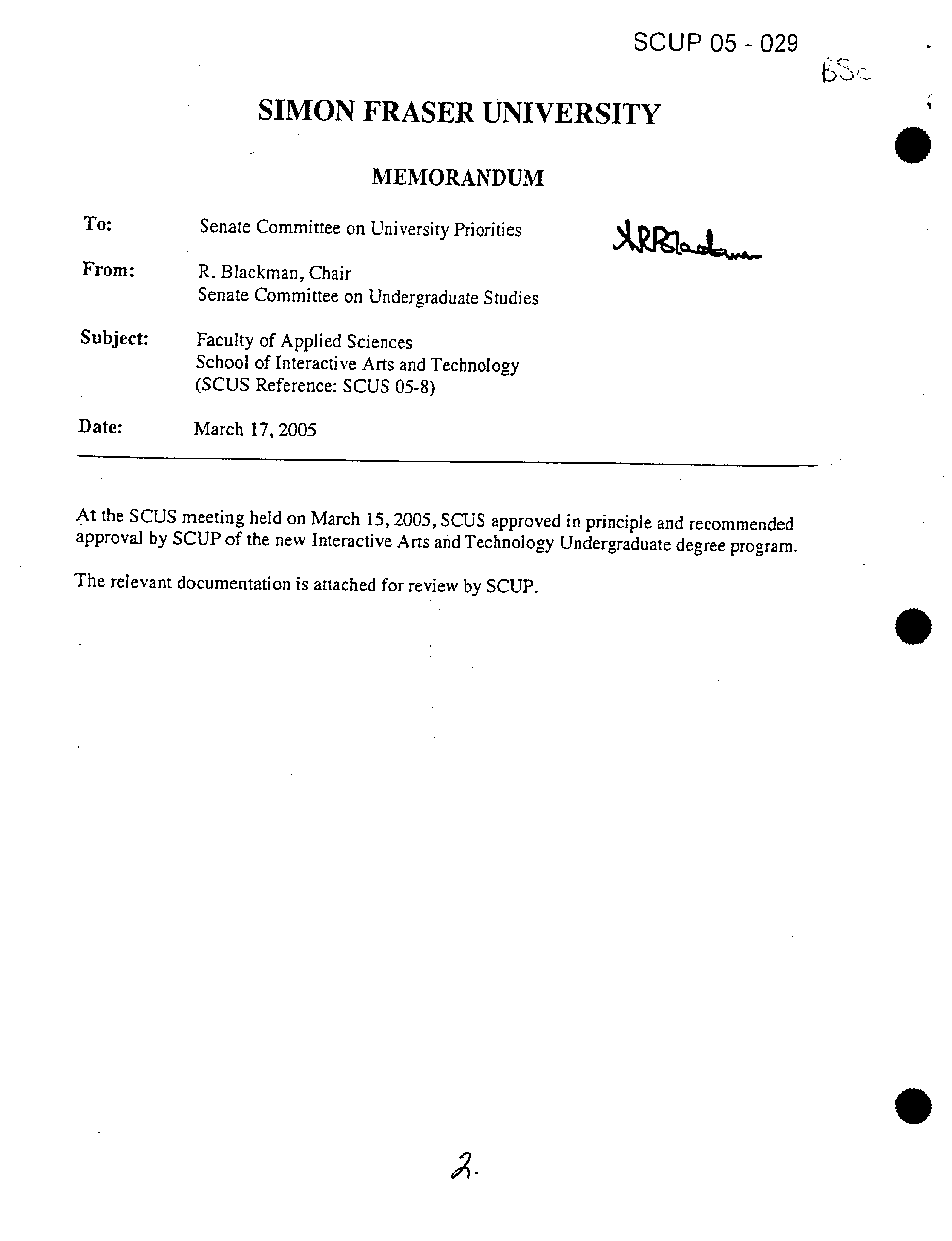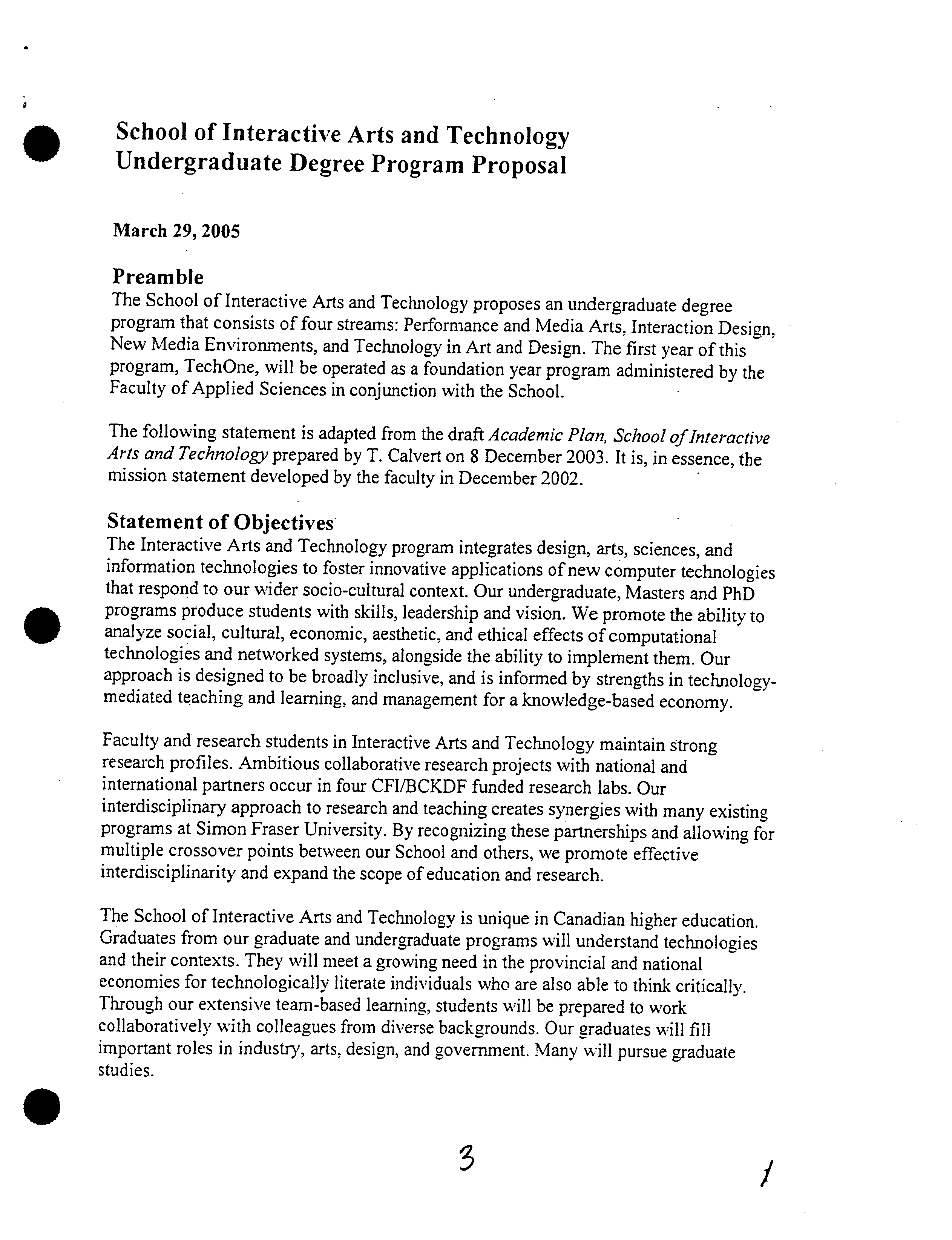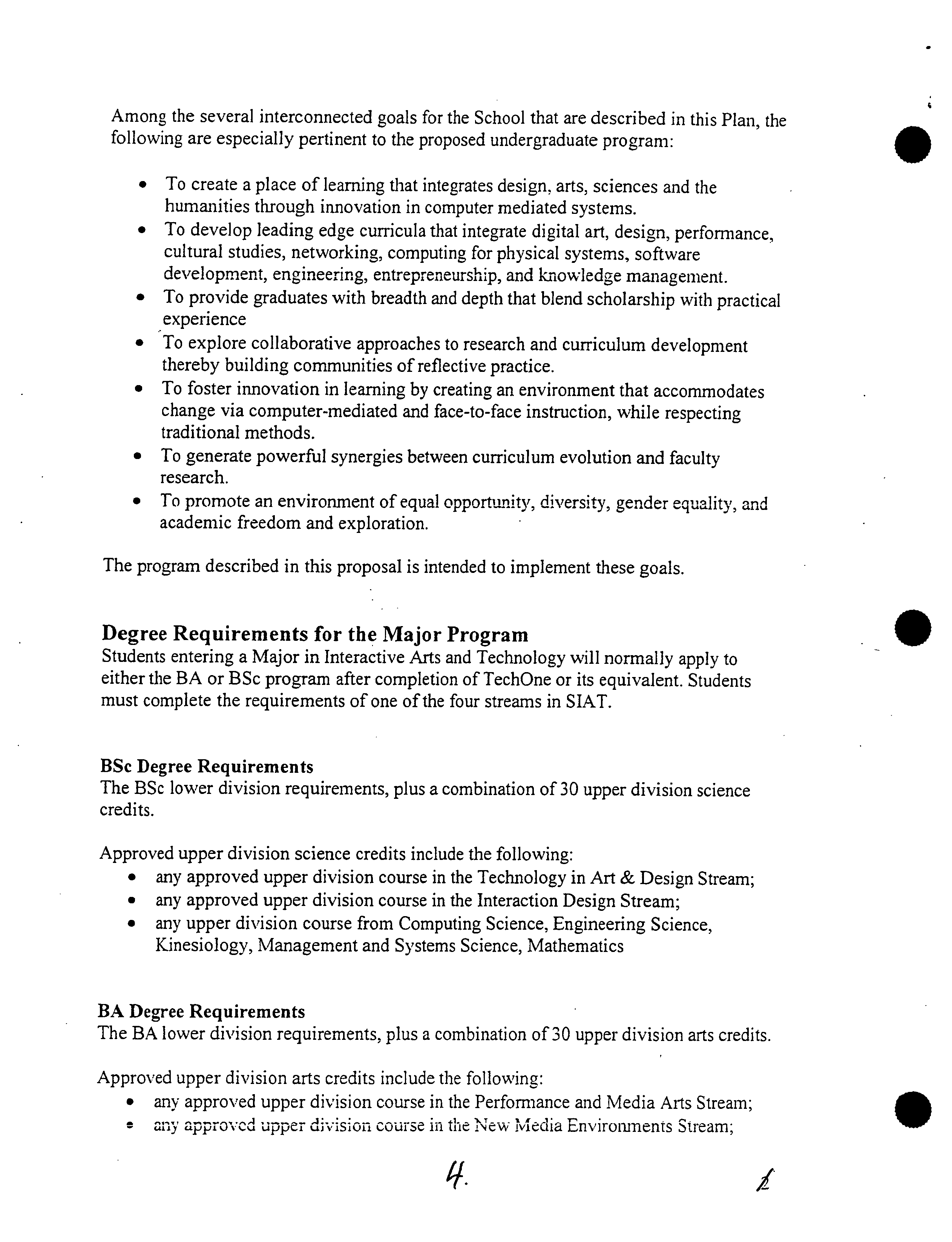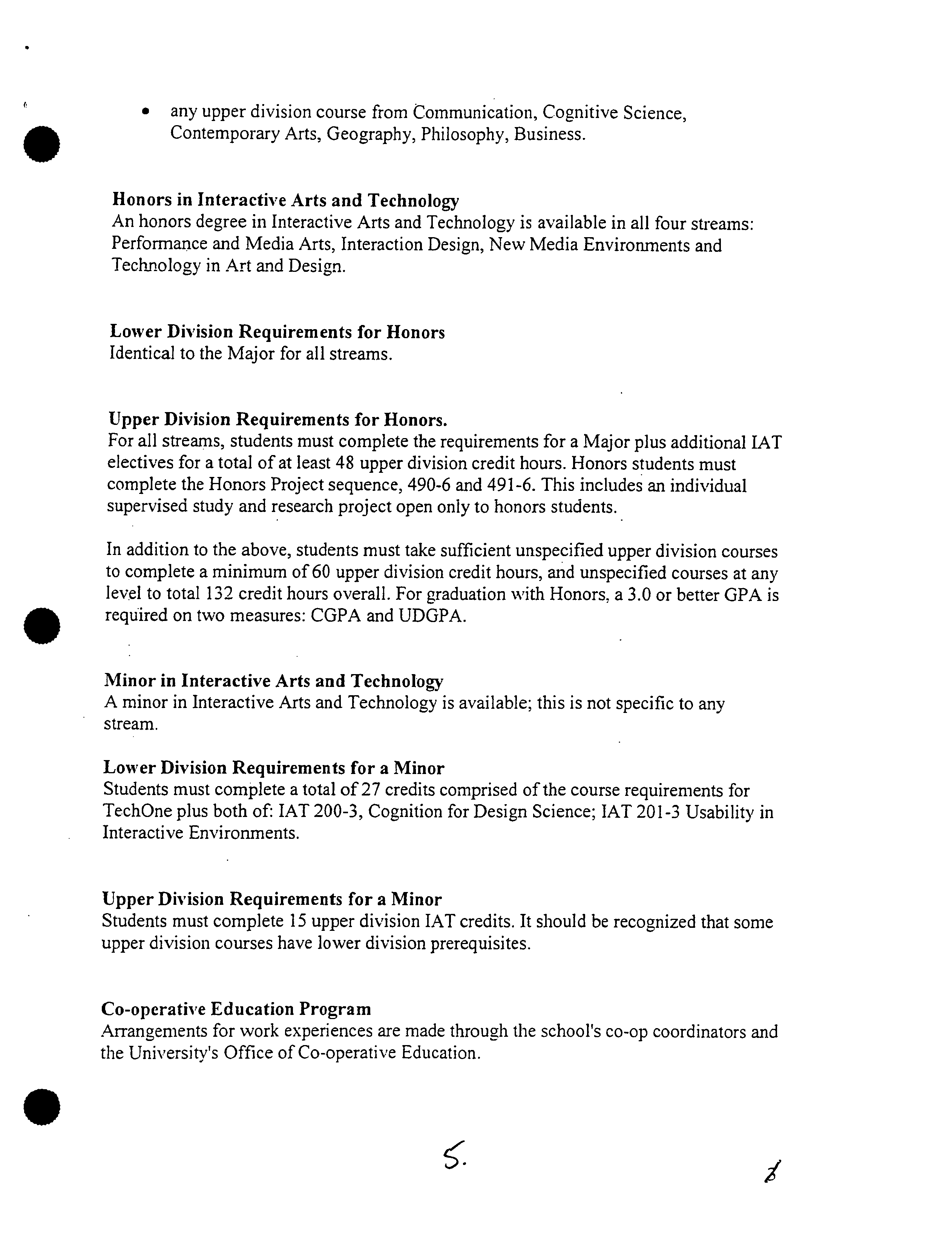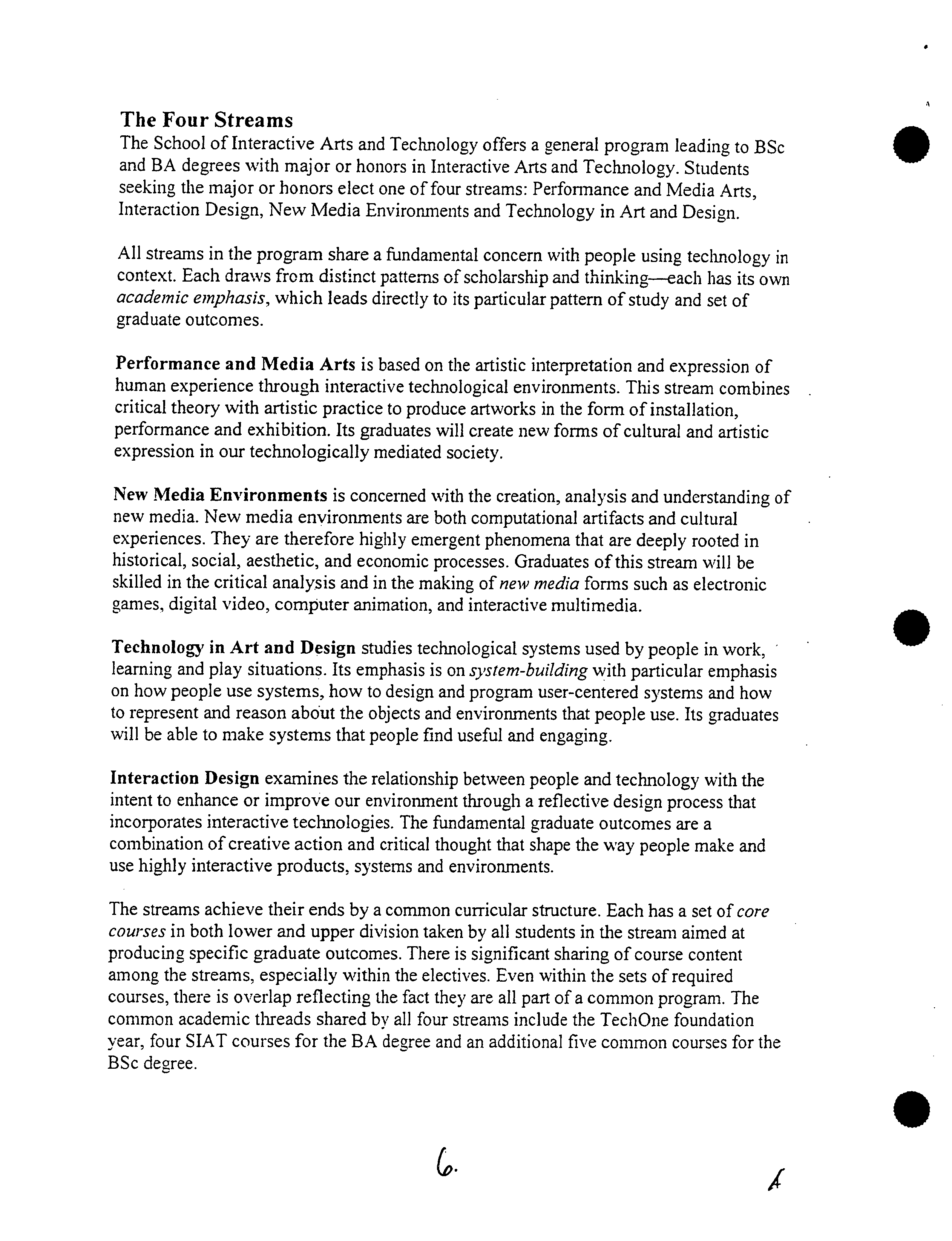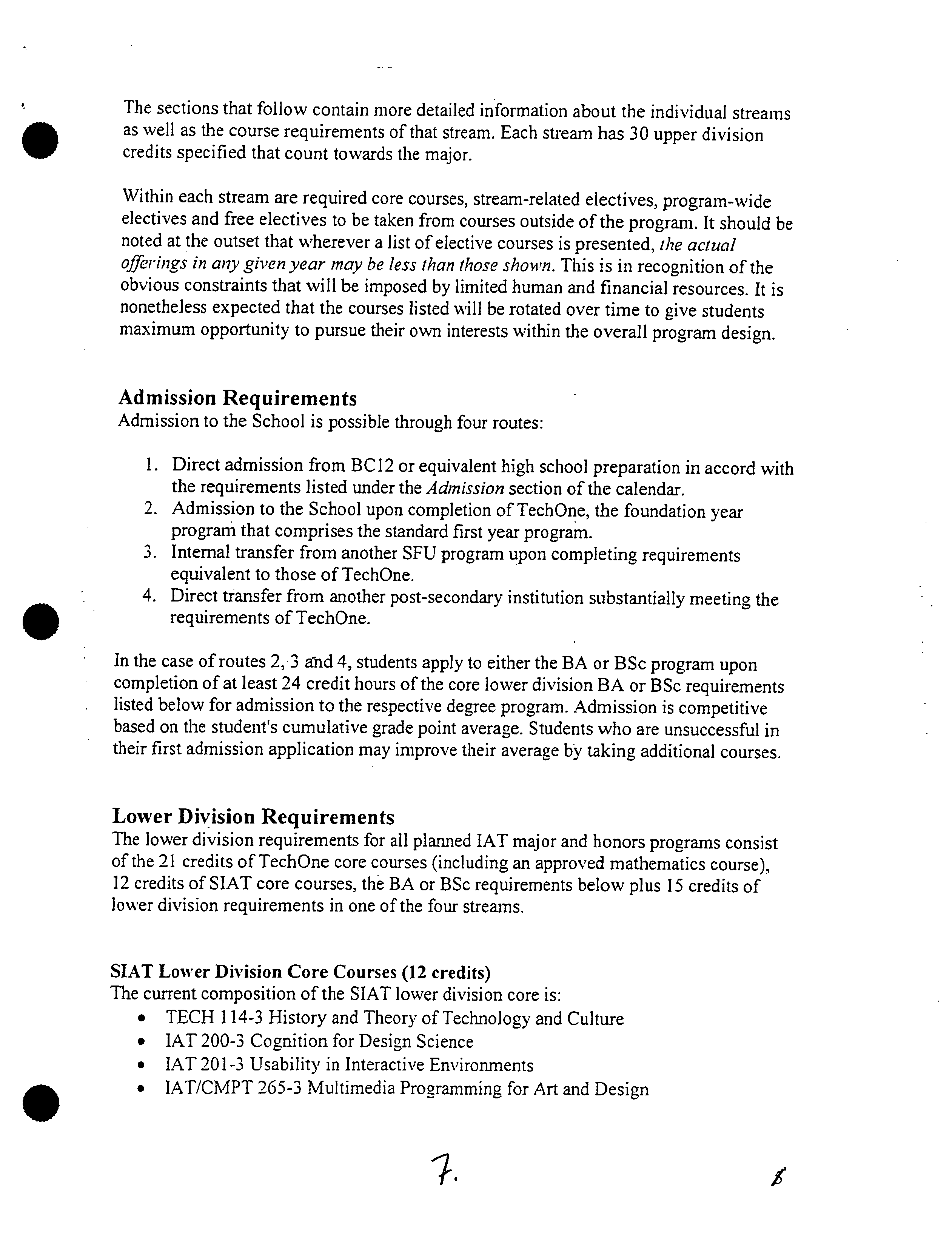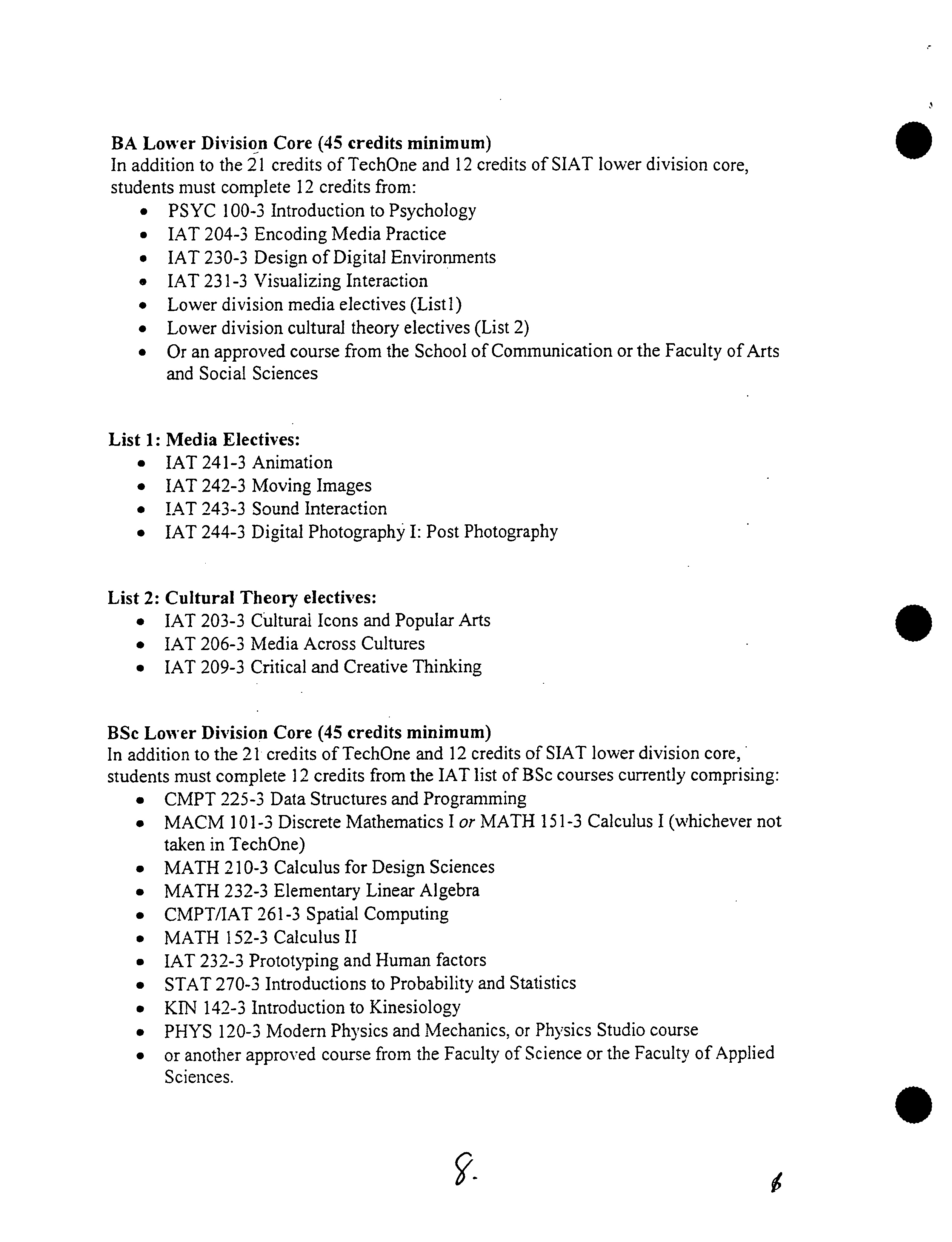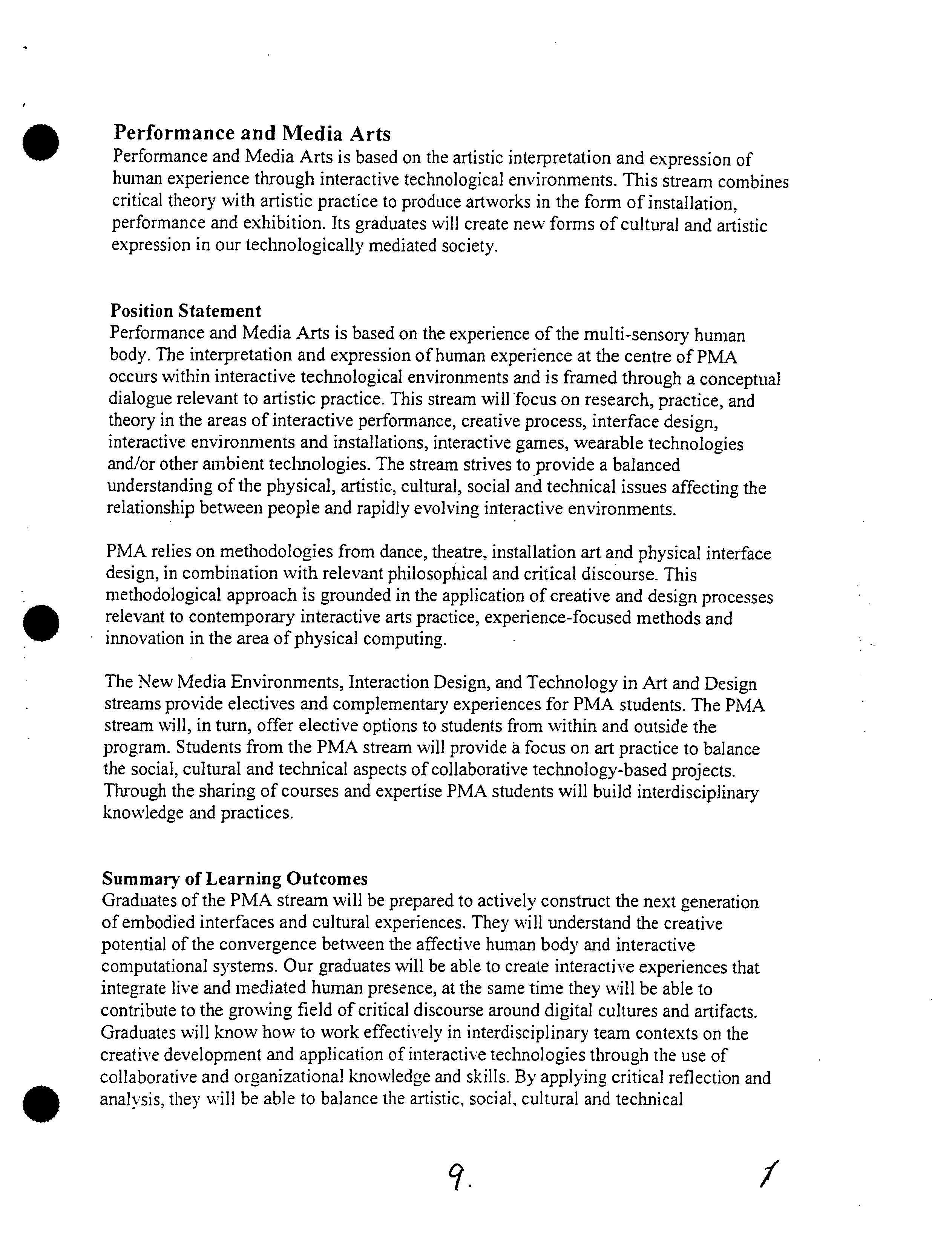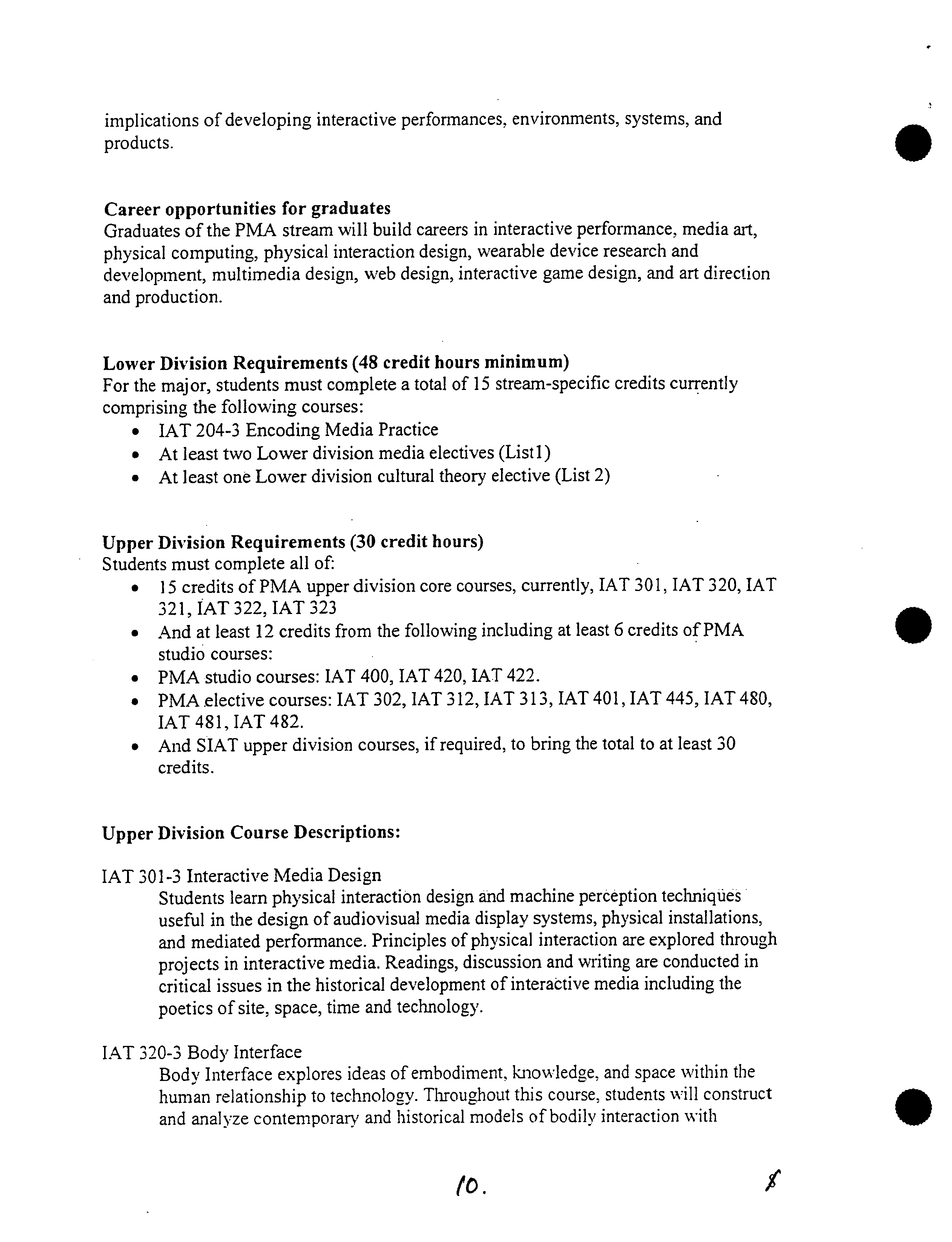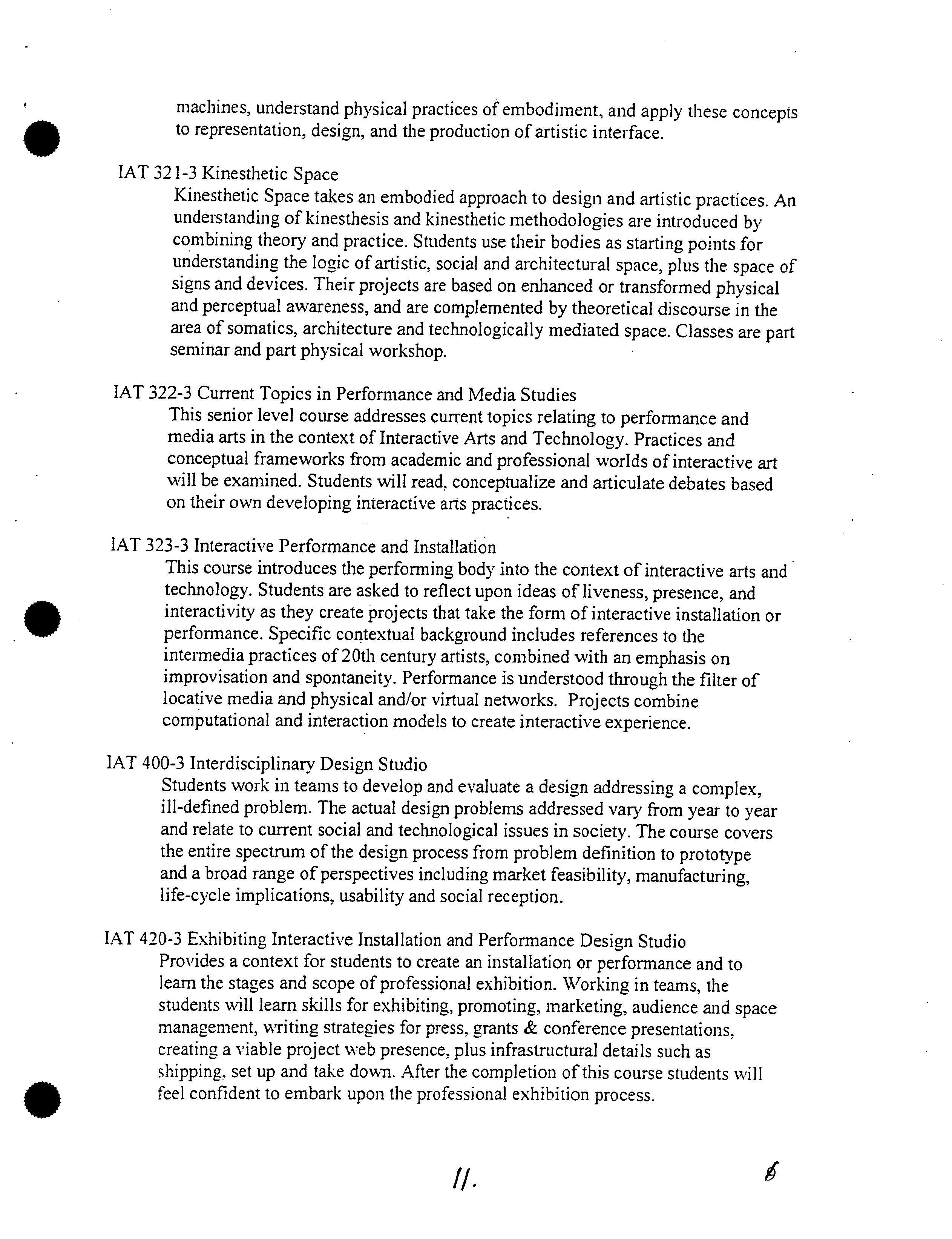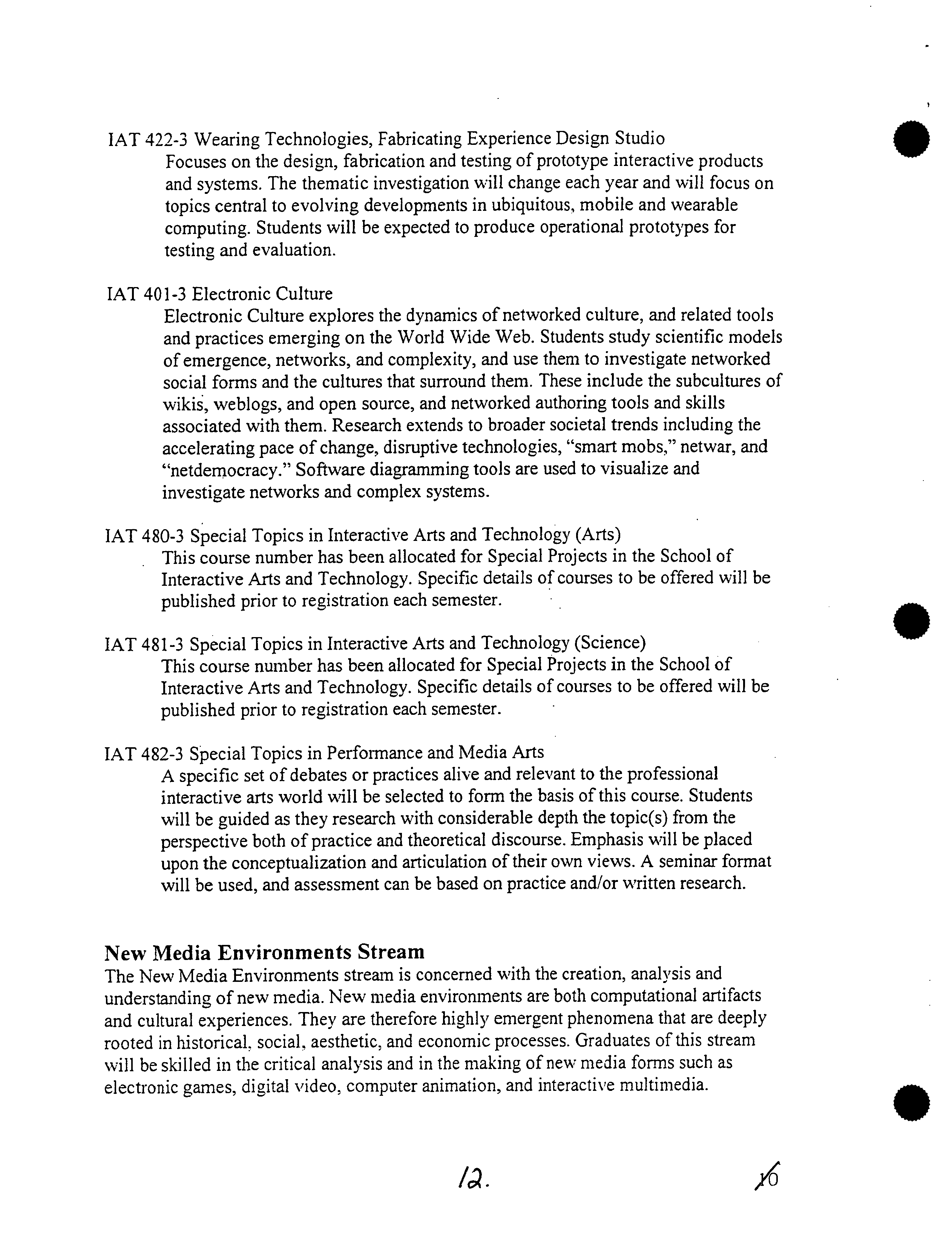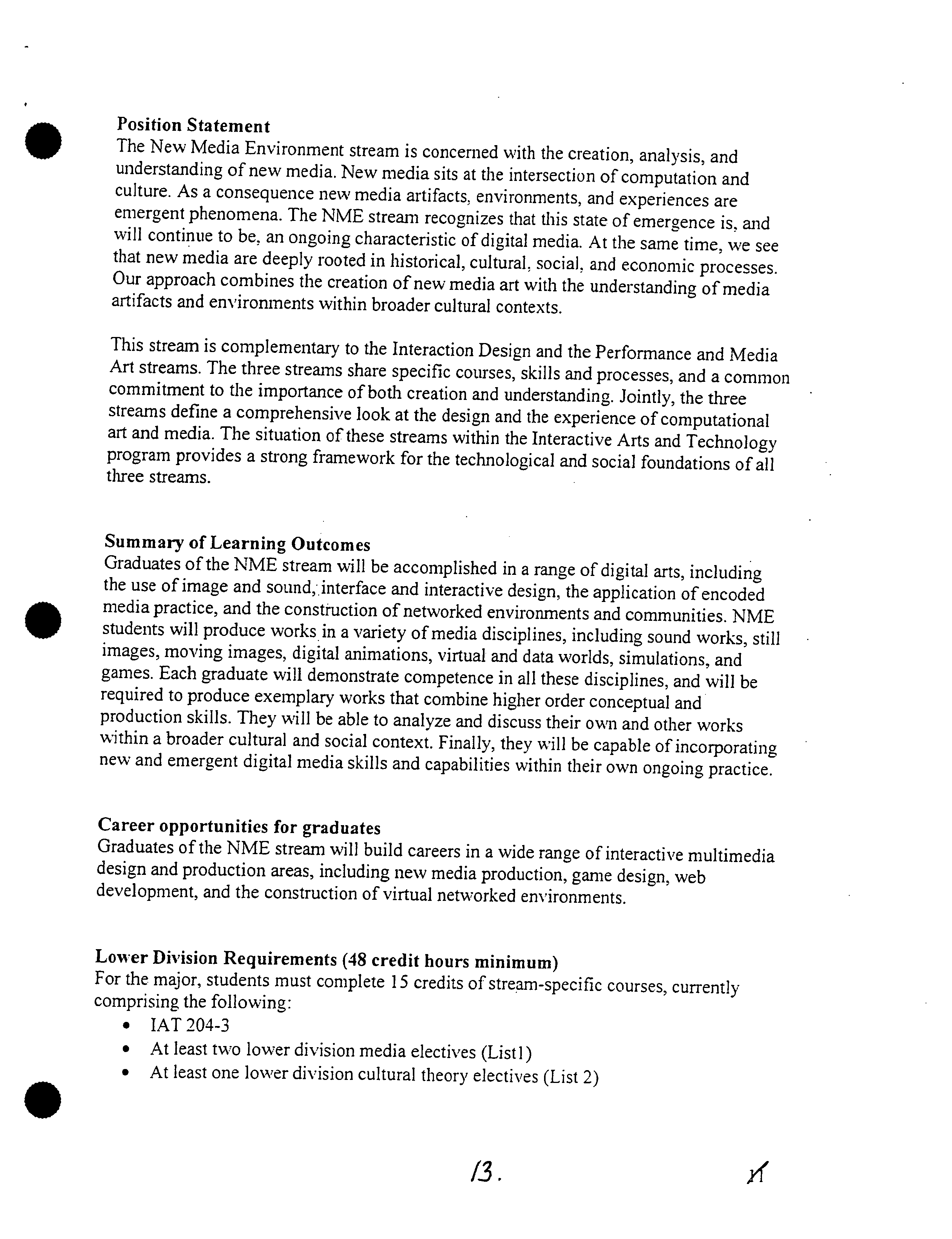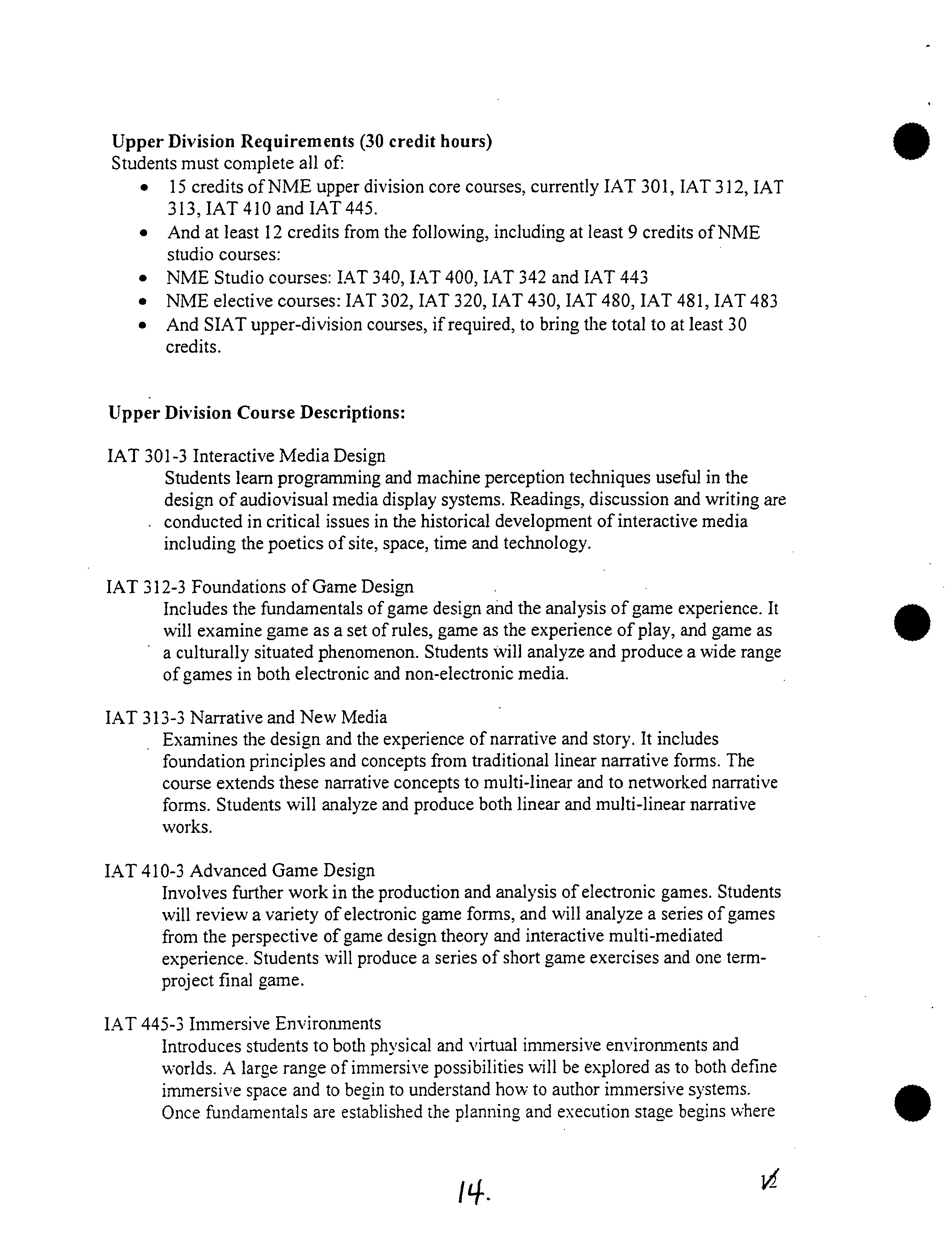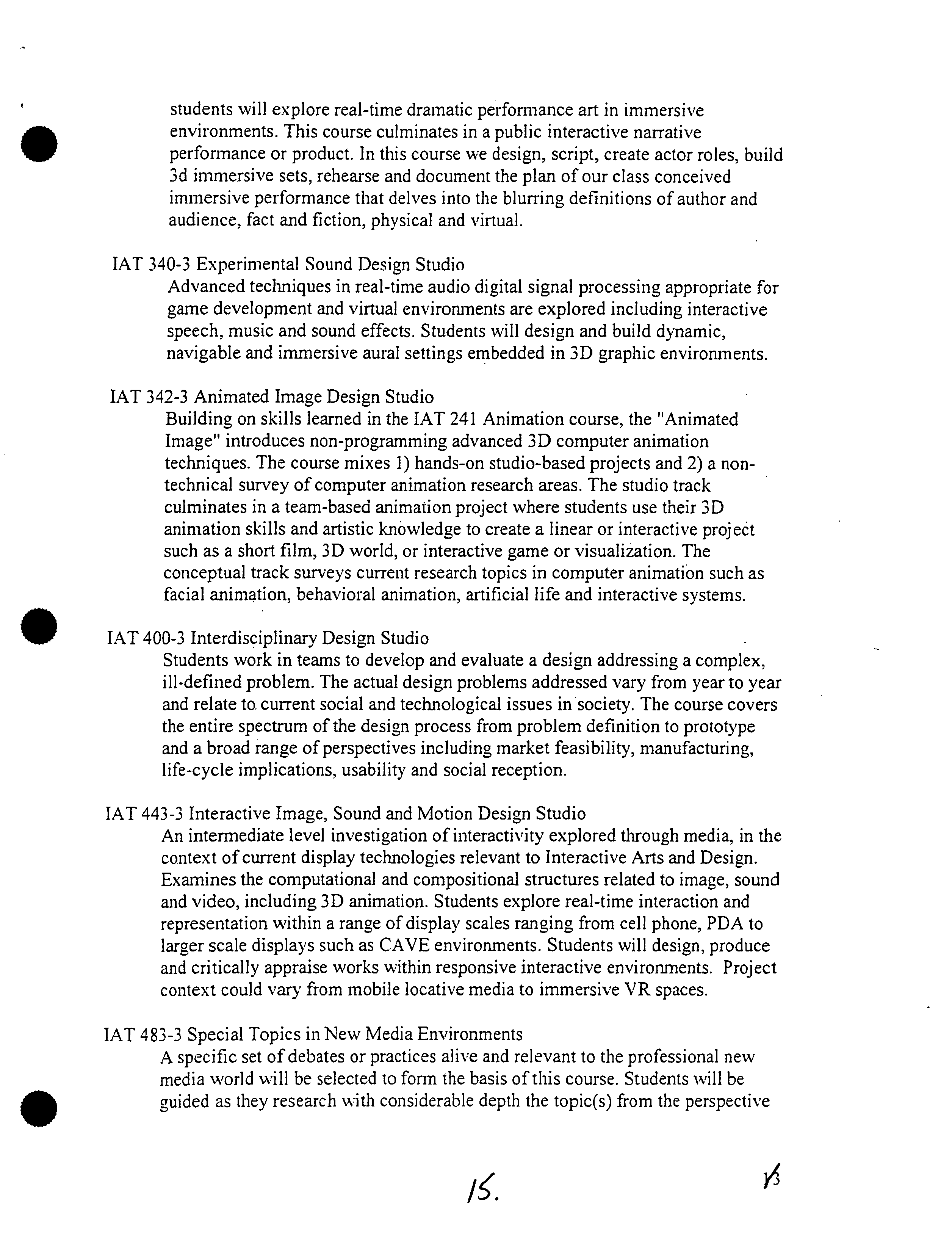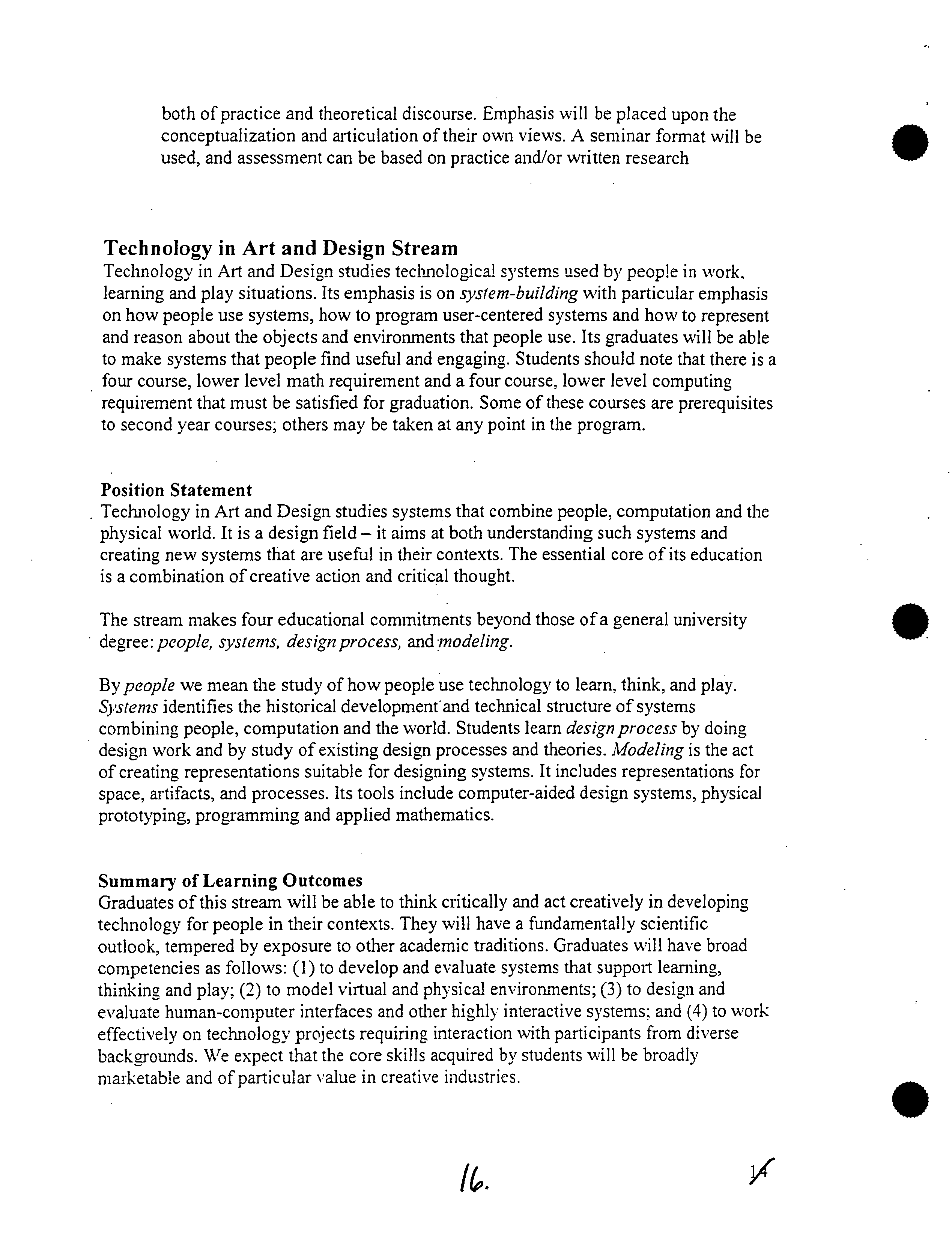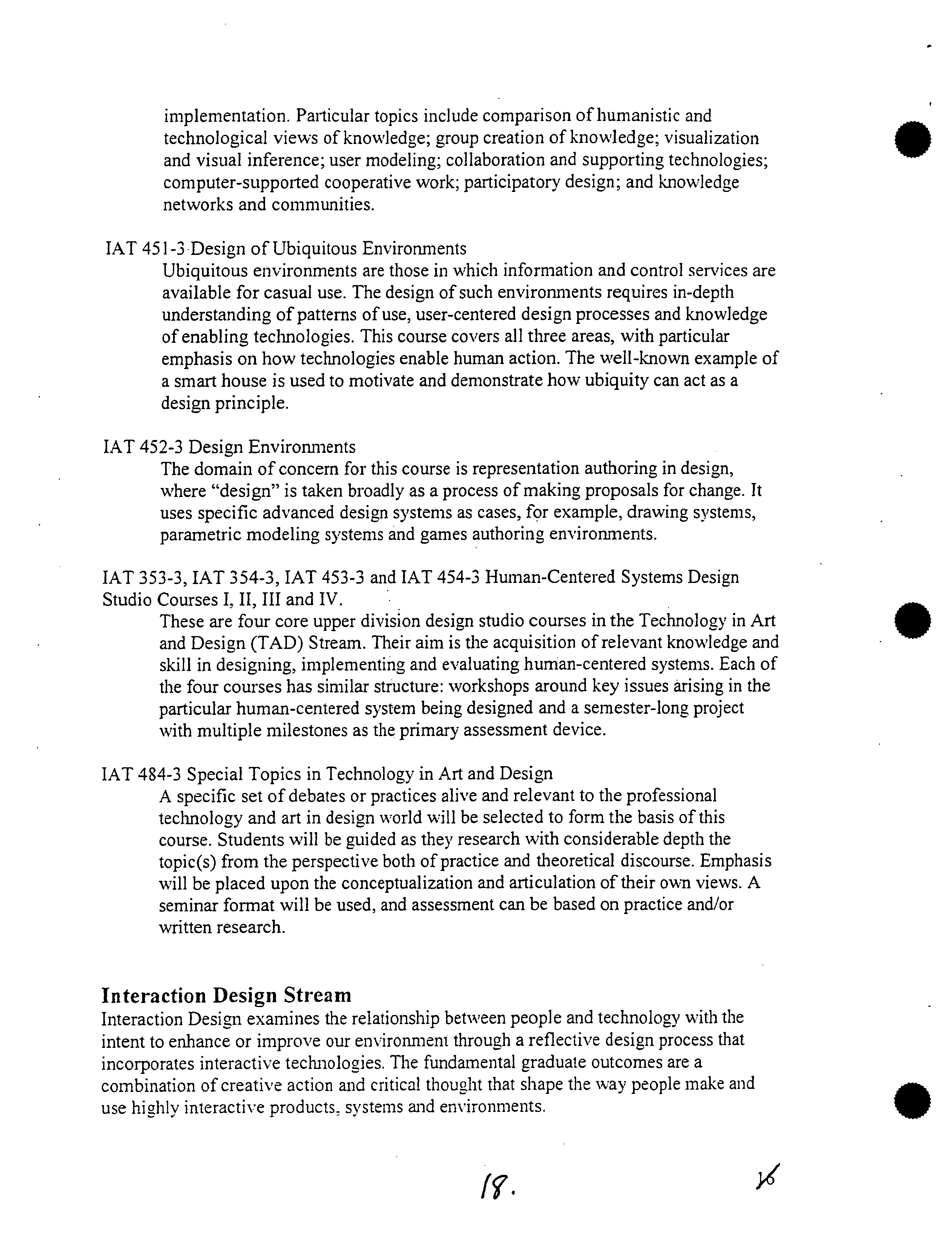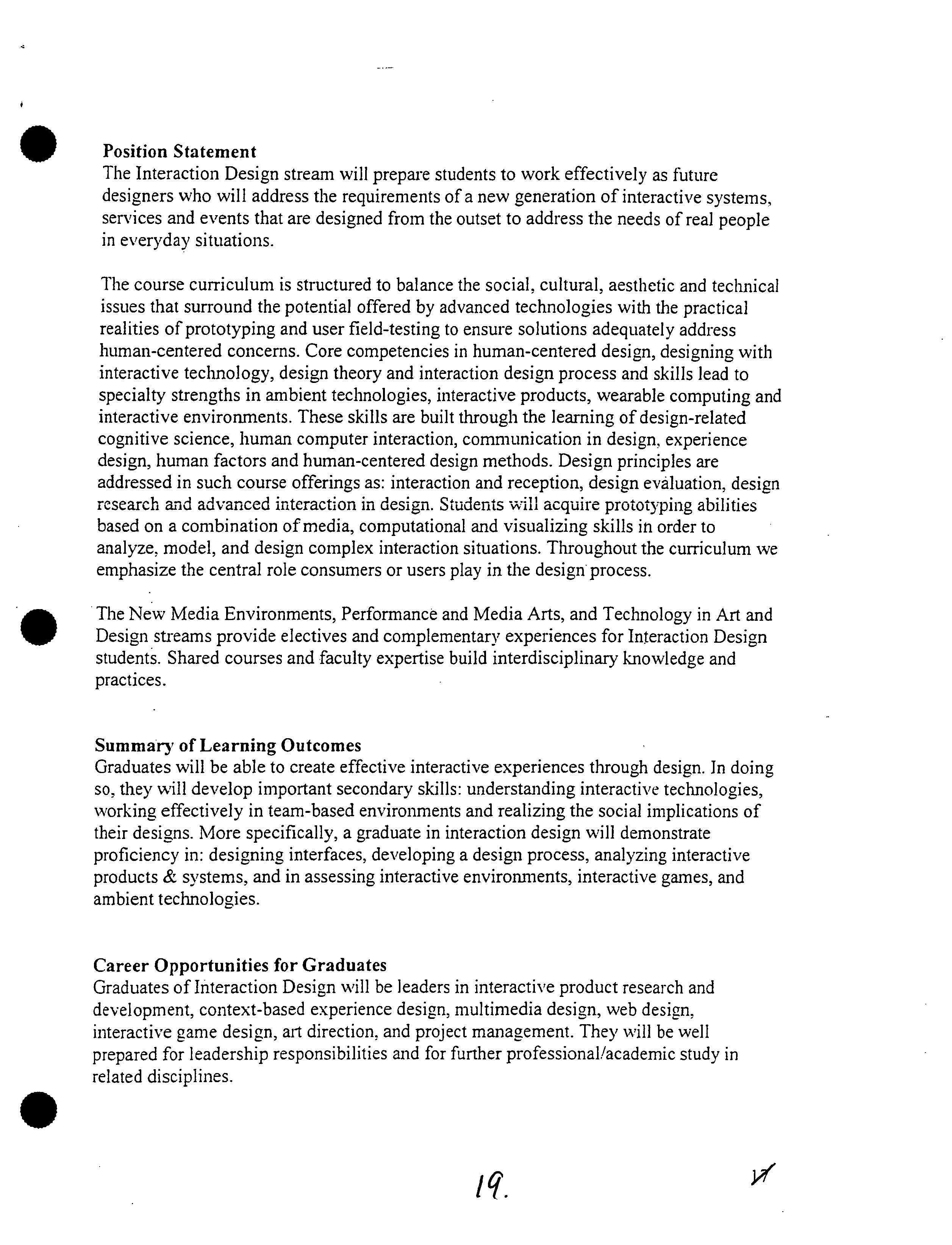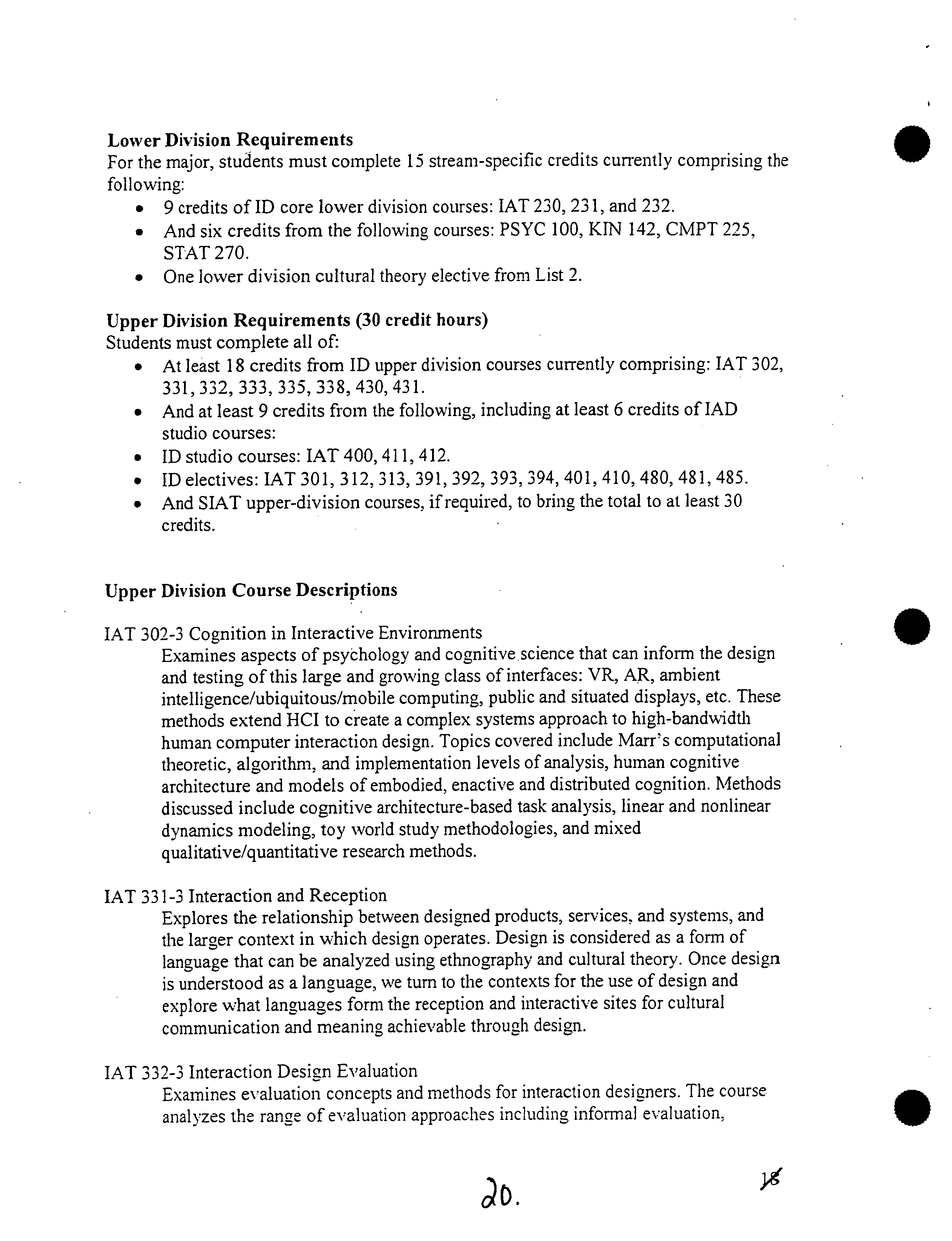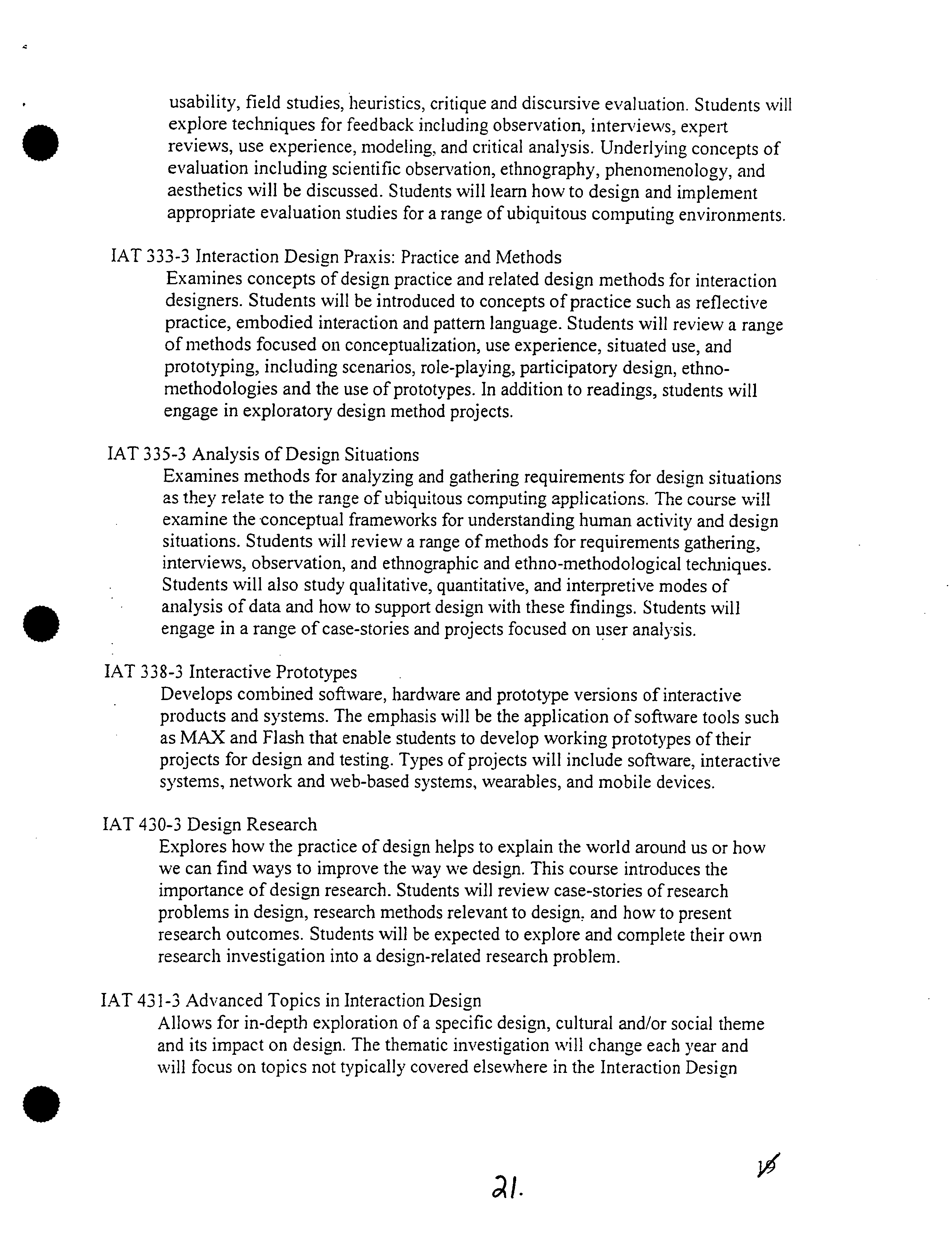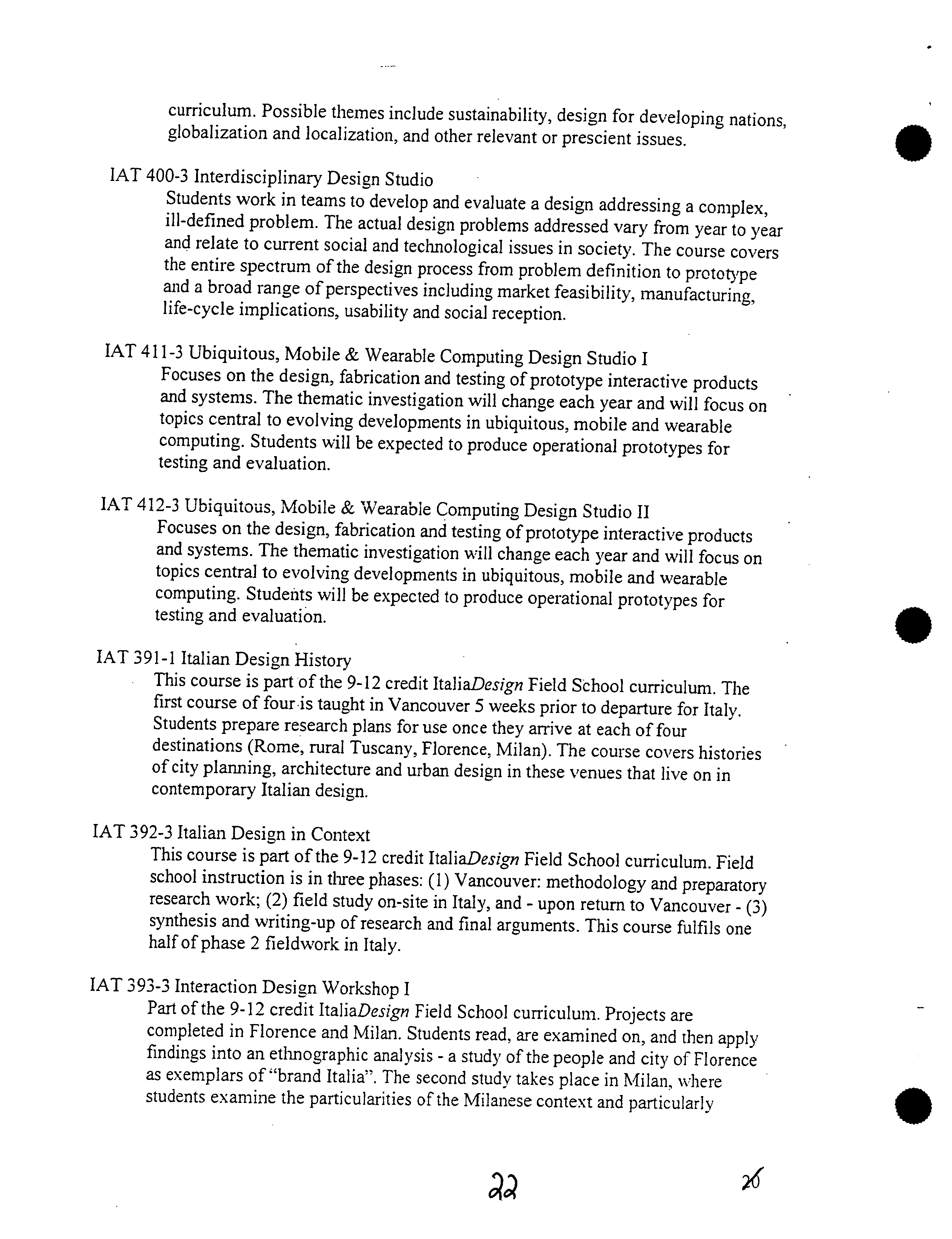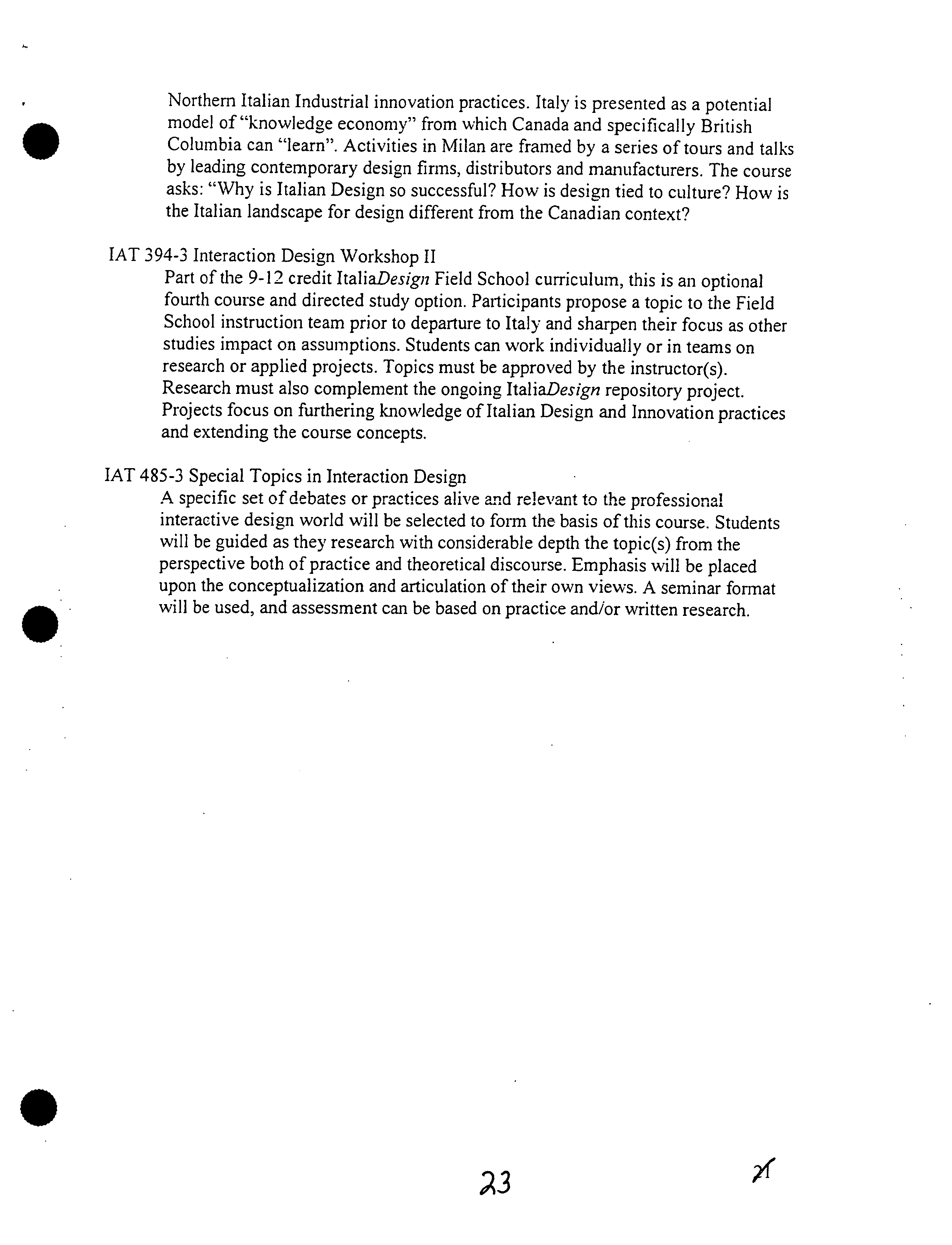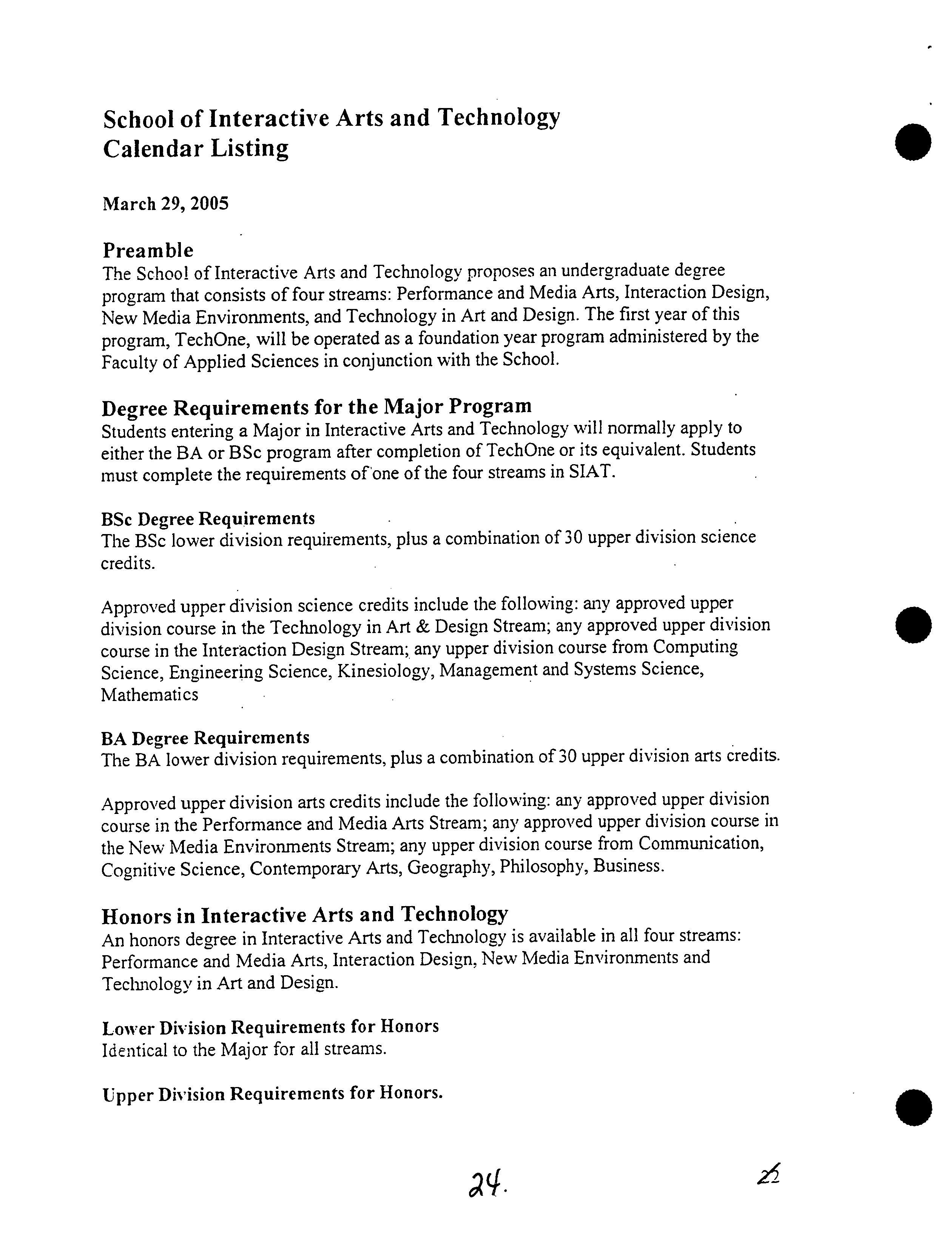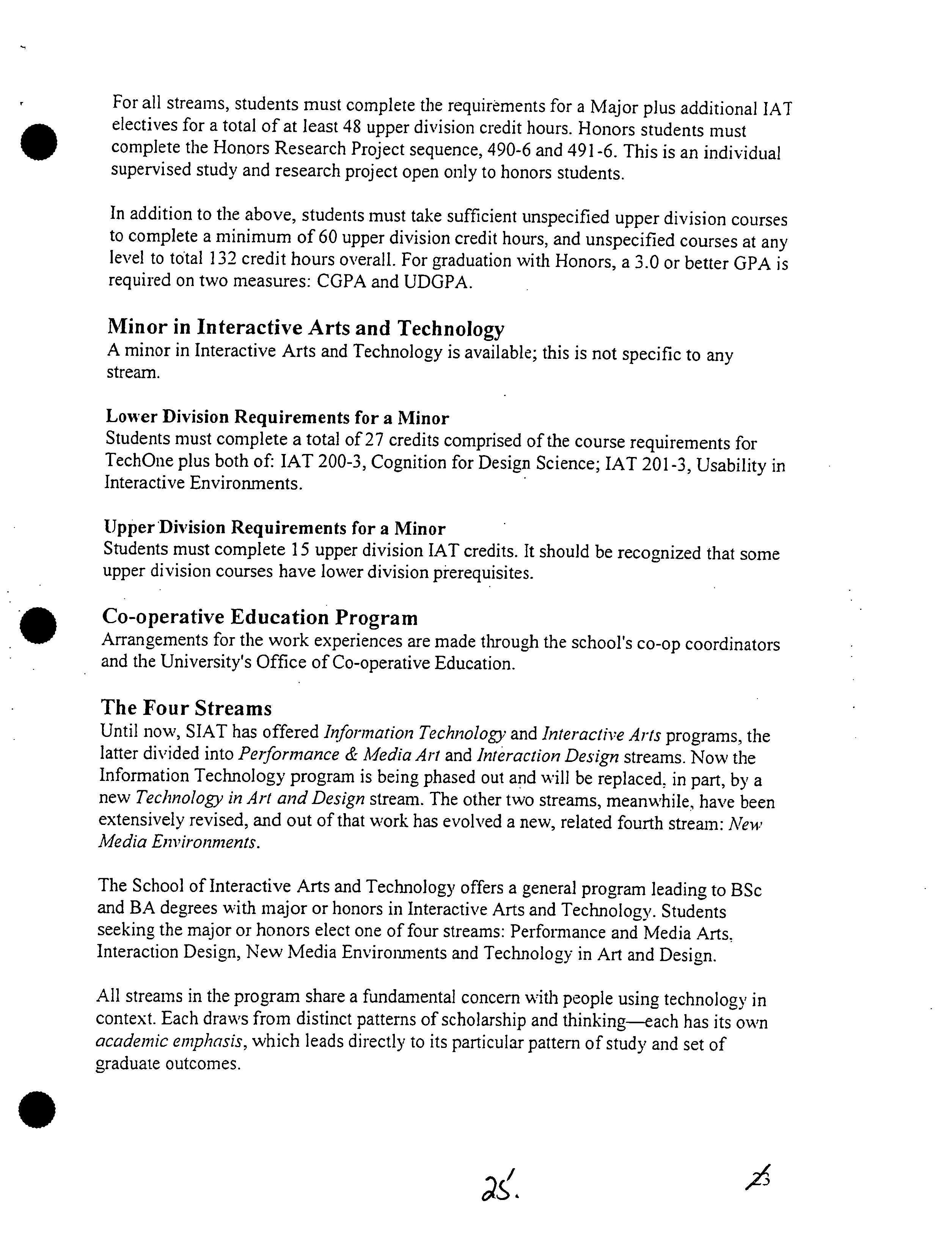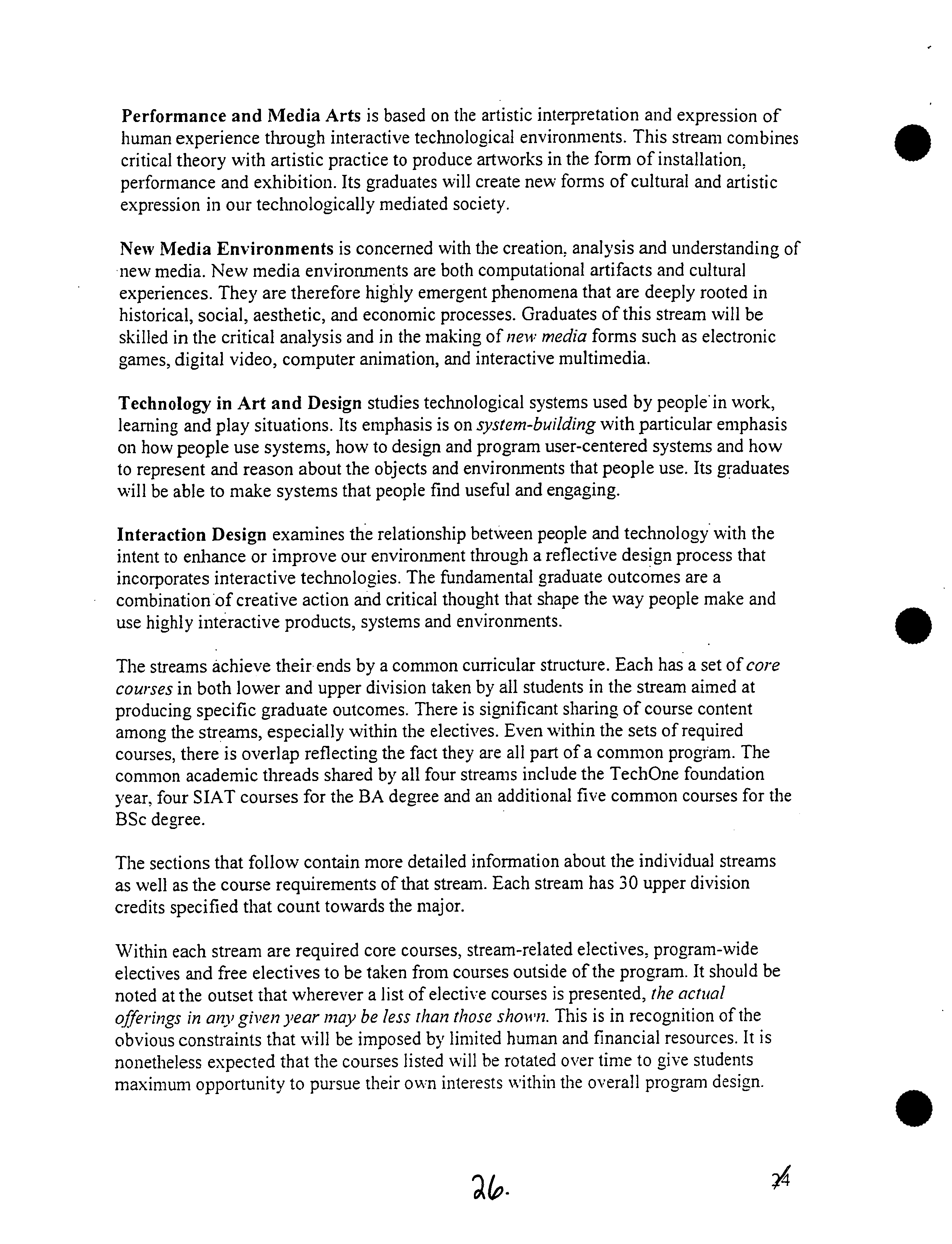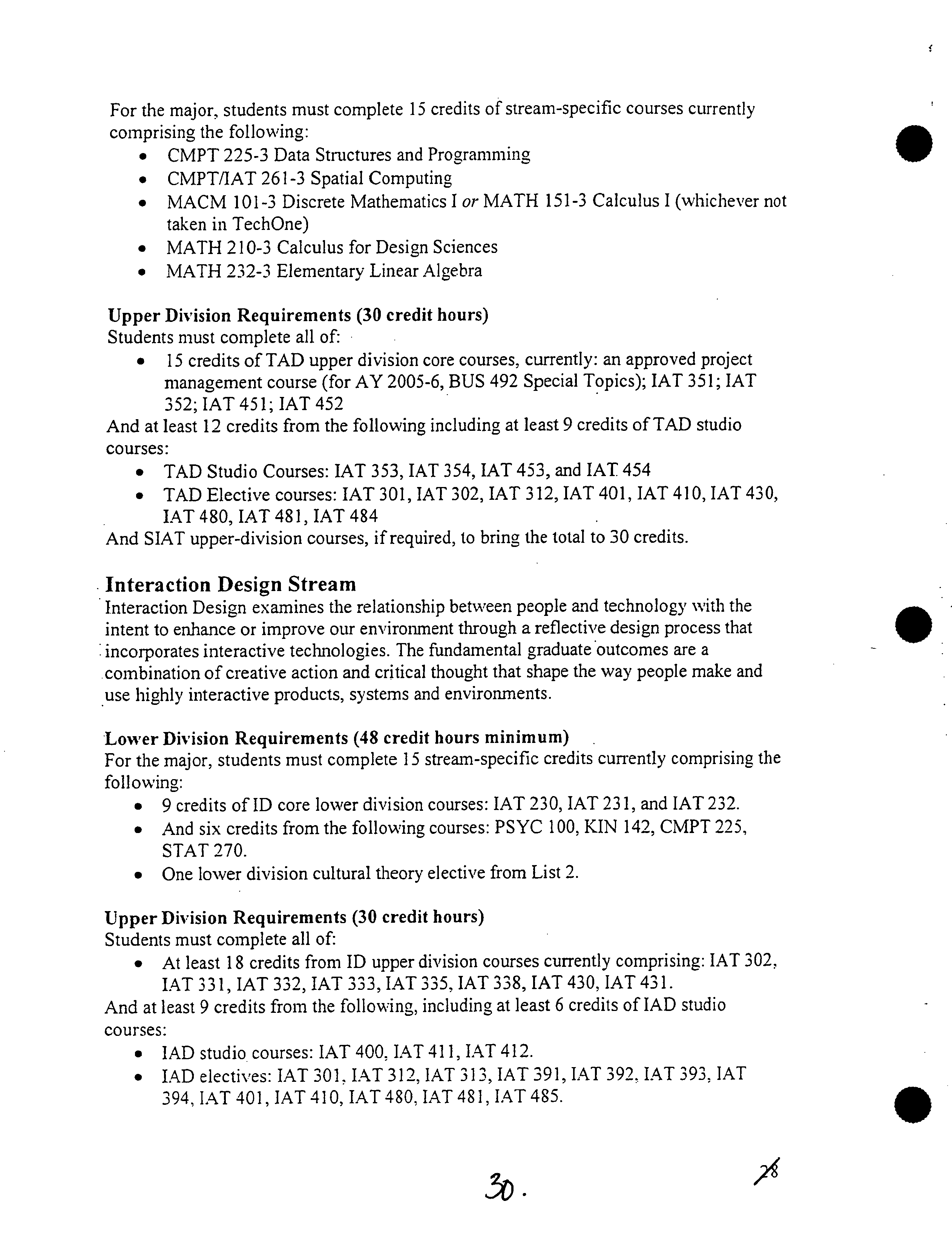
0
?
SIMON FRASER UNIVERSITY
?
S.05-67
S ?
Senate Committee on University Priorities
Memorandum
TO:
Senate
FROM:
John Waterh
Chair, SCUP
Vice Preside
RE:
Proposal for a Bachelor of Arts/ ?
DATE: ?
April
11,
200
Bachelor of Science, Major or Honors in
Interactive Arts and Technology
(SCUP 05-028/ SCUP 05-029)
At its March 23, 2005 meeting SCUP reviewed and approved the proposal from the
Senate Committee on Undergraduate Studies for the establishment of a Bachelor of
Arts and a Bachelor of Science, Major or Honors in Interactive Arts and
Technology, which is now forwarded to Senate for approval.
Motion
That Senate approve and recommend to the Board of Governors the proposal for a
Bachelor of Arts, Major or Honors in Interactive Arts and Technology.
Motion
That Senate approve and recommend to the Board of Governors the proposal for a
Bachelor of Science, Major or Honors in Interactive Arts and Technology.
end.
Cr
J. Bowes
B. Lewis
J. Jones
R. Woodbury
J. Budd
0
SOUP 05 - 028
SIMON FRASER UNIVERS1
MEMORANDUM
From:
To:
??
R.
Senate
Blackman,
Committee
Chair
on University Priorities
?
*RL-J^^
Senate Committee on Undergraduate Studies
Subject:
?
Faculty of Applied Sciences
School of Interactive Arts and Technology
(SCUS Reference: SCUS 05-8)
Date: ?
March 17, 2005
At the SCUS meeting held on March 15,
2005,
SCLJS approved in principle and recommended
approval by SCUP of the new Interactive Arts and Technology Undergraduate degree program.
The relevant documentation is attached for review by SCUP.
SOUP 05 - 029
SIMON FRASER UNIVERSITY
MEMORANDUM
From:
To: ??
R.
Senate
Blackman,
Committee
Chair
on University Priorities
?
Amo-^^
Senate Committee on Undergraduate Studies
Subject: ?
Faculty of Applied Sciences
School of Interactive Arts and Technology
(SCUS Reference: SCUS 05-8)
Date: ?
March 17, 2005
At the SCUS meeting held on March
15, 2005,
SCUS approved in principle and recommended
approval by SCUP of the new Interactive Arts and Technology Undergraduate degree program.
The relevant documentation is attached for review by SCUP.
.
• ?
School of Interactive Arts and Technology
Undergraduate Degree Program Proposal
March 29, 2005
Preamble
The School of Interactive Arts and Technology proposes an undergraduate degree
program that consists of four streams: Performance and Media Arts, Interaction Design,
New Media Environments, and Technology in Art and Design. The first year of this
program, TechOne, will be operated as a foundation year program administered by the
Faculty of Applied Sciences in conjunction with the School.
The following statement is adapted from the draft
Academic Plan, School of Interactive
Arts
and Technology
prepared by T. Calvert on 8 December 2003. It is, in essence, the
mission statement developed by the faculty in December 2002.
Statement of Objectives
The Interactive Arts and Technology program integrates design, arts, sciences, and
information technologies to foster innovative applications of new computer technologies
that respond to our wider socio-cultural context. Our undergraduate, Masters and PhD
• ?
programs produce students with skills, leadership and vision. We promote the ability to
analyze social, cultural, economic, aesthetic, and ethical effects of computational
technologies and networked systems, alongside the ability to implement them. Our
approach is designed to be broadly inclusive, and is informed by strengths in technology-
mediated teaching and learning, and management for a knowledge-based economy.
Faculty and research students in Interactive Arts and Technology maintain strong
research profiles. Ambitious collaborative research projects with national and
international partners occur in four CFI/BCKDF funded research labs. Our
interdisciplinary approach to research and teaching creates synergies with many existing
programs at Simon Fraser University. By recognizing these partnerships and allowing for
multiple crossover points between our School and others, we promote effective
interdisciplinarity and expand the scope of education and research.
The School of Interactive Arts and Technology is unique in Canadian higher education.
Graduates from our graduate and undergraduate programs will understand technologies
and their contexts. They will meet a growing need in the provincial and national
economies for technologically literate individuals who are also able to think critically.
Through our extensive team-based learning, students will be prepared to work
collaboratively with colleagues from diverse backgrounds. Our graduates will fill
important roles in industry, arts, design, and government. Many will pursue graduate
studies.
S
/
Among the several interconnected goals for the School that are described in this Plan, the
following are especially pertinent to the proposed undergraduate program:
?
0
• To create a place of learning that integrates design, arts, sciences and the
humanities through innovation in computer mediated systems.
• To develop leading edge curricula that integrate digital art, design, performance,
cultural studies, networking, computing for physical systems, software
development, engineering, entrepreneurship, and knowledge management.
• To provide graduates with breadth and depth that blend scholarship with practical
experience
• To explore collaborative approaches to research and curriculum development
thereby building communities of reflective practice.
• To foster innovation in learning by creating an environment that accommodates
change via computer-mediated and face-to-face instruction, while respecting
traditional methods.
• To generate powerful synergies between curriculum evolution and faculty
research.
• To promote an environment of equal opportunity, diversity, gender equality, and
academic freedom and exploration.
The program described in this proposal is intended to implement these goals.
Degree Requirements for the Major Program
Students entering a Major in Interactive Arts and Technology will normally apply to
either the BA or BSc program after completion of TechOne or its equivalent. Students
must complete the requirements of one of the four streams in SlAT.
BSc Degree Requirements
The BSc lower division requirements, plus a combination of 30 upper division science
credits.
Approved upper division science credits include the following:
• any approved upper division course in the Technology in Art & Design Stream;
• any approved upper division course in the Interaction Design Stream;
• any upper division course from Computing Science, Engineering Science,
Kinesiology, Management and Systems Science, Mathematics
BA Degree Requirements
The BA lower division requirements, plus a combination of 30 upper division arts credits.
Approved upper division arts credits include the following:
• any approved upper division course in the Performance and Media Arts Stream;?
any approved
upper
division course in the New Media Environments Stream;
41.
?
1
. any upper division course from Communication, Cognitive Science,
Contemporary Arts, Geography, Philosophy, Business.
Honors in Interactive Arts and Technology
An honors degree in Interactive Arts and Technology is available in all four streams:
Performance and Media Arts, Interaction Design, New Media Environments and
Technology in Art and Design.
Lower Division Requirements for Honors
Identical to the Major for all streams.
Upper Division Requirements for Honors.
For all streams, students must complete the requirements for a Major plus additional TAT
electives for a total of at least 48 upper division credit hours. Honors students must
complete the Honors Project sequence, 490-6 and 491-6. This includes an individual
supervised study and research project open only to honors students.
In addition to the above, students must take sufficient unspecified upper division courses
to complete a minimum of 60 upper division credit hours, and unspecified courses at any
level to total 132 credit hours overall. For graduation with Honors, a 3.0 or better GPA is
required on two measures: CGPA and UDGPA.
Minor in Interactive Arts and Technology
A minor in Interactive Arts and Technology is available; this is not specific to any
stream.
Lower Division Requirements for a Minor
Students must complete a total of 27 credits comprised of the course requirements for
TechOne plus both of: TAT 200-3, Cognition for Design Science; TAT 201-3 Usability in
Interactive Environments.
Upper Division Requirements for a Minor
Students must complete 15 upper division IAT credits. It should be recognized that some
upper division courses have lower division prerequisites.
Co-operative Education Program
Arrangements for work experiences are made through the school's co-op coordinators and
the University's Office of Co-operative Education.
I
The Four Streams
The School of Interactive Arts and Technology offers a general program leading to BSc
and BA degrees with major or honors in Interactive Arts and Technology. Students
seeking the major or honors elect one of four streams: Performance and Media Arts,
Interaction Design, New Media Environments and Technology in Art and Design.
All streams in the program share a fundamental concern with people using technology in
context. Each draws from distinct patterns of scholarship and thinking—each has its own
academic emphasis,
which leads directly to its particular pattern of study and set of
graduate outcomes.
Performance and Media Arts
is based on the artistic interpretation and expression of
human experience through interactive technological environments. This stream combines
critical theory with artistic practice to produce artworks in the form of installation,
performance and exhibition. Its graduates will create new forms of cultural and artistic
expression in our technologically mediated society.
New Media Environments
is concerned with the creation, analysis and understanding of
new media. New media environments are both computational artifacts and cultural
experiences. They are therefore highly emergent phenomena that are deeply rooted in
historical, social, aesthetic, and economic processes. Graduates of this stream will be
skilled in the critical analysis and in the making of
new media
forms such as electronic
Technology
games, digital
in
video,
Art and
computer
Design
animation,
studies technological
and interactive
systems
multimedia.used
by people in work,
0
learning and play situations. Its emphasis is on
system-building
with particular emphasis
on how people use systems, how to design and program user-centered systems and how
to represent and reason about the objects and environments that people use. Its graduates
will be able to make systems that people find useful and engaging.
Interaction Design
examines the relationship between people and technology with the
intent to enhance or improve our environment through a reflective design process that
incorporates interactive technologies. The fundamental graduate outcomes are a
combination of creative action and critical thought that shape the way people make and
use highly interactive products, systems and environments.
The streams achieve their ends by a common curricular structure. Each has a set
of core
courses in both lower and upper division taken by all students in the stream aimed at
producing specific graduate outcomes. There is significant sharing of course content
among the streams, especially within the electives. Even within the sets of required
courses, there is overlap reflecting the fact they are all part of a common program. The
common academic threads shared b
y
all four streams include the TechOne foundation
year, four SlAT courses for the BA degree and an additional five common courses for the
BSc degree.
.
CD. ?
I'
The sections that follow contain more detailed information about the individual streams
. ?
as well as the course requirements of that stream. Each stream has 30 upper division
credits specified that count towards the major.
Within each stream are required core courses, stream-related electives, program-wide
electives and free electives to be taken from courses outside of the program. It should be
noted at the outset that wherever a list of elective courses is presented,
the actual
O ff
erings
in any given year maybe less than those shown.
This is in recognition of the
obvious constraints that will be imposed by limited human and financial resources. It is
nonetheless expected that the courses listed will be rotated over time to give students
maximum opportunity to pursue their own interests within the overall program design.
Admission Requirements
Admission to the School is possible through four routes:
1.
Direct admission from BCl2 or equivalent high school preparation in accord with
the requirements listed under the
Admission
section of the calendar.
2.
Admission to the School upon completion of TechOne, the foundation year
program that comprises the standard first year program.
3.
Internal transfer from another SFU program upon completing requirements
equivalent to those of TechOne.
4.
Direct transfer from another post-secondary institution substantially meeting the
requirements of TechOne.
In the case of routes 2, 3 and 4, students apply to either the BA or BSc program upon
completion of at least 24 credit hours of the core lower division BA or BSc requirements
listed below for admission to the respective degree program. Admission is competitive
based on the student's cumulative grade point average. Students who are unsuccessful in
their first admission application may improve their average by taking additional courses.
Lower Division Requirements
The lower division requirements for all planned IAT major and honors programs Consist
of the 21 credits of TechOne core courses (including an approved mathematics course).
12 credits of SlAT core courses, the BA or BSc requirements below plus 15 credits of
lower division requirements in one of the four streams.
SlAT Lower Division Core Courses (12 credits)
The current composition of the STAT lower division core is:
• TECH 114-3 History and Theory of Technology and Culture
• IAT 200-3 Cognition for Design Science
• lAY 201-3 Usability in Interactive Environments
• IAT/CMPT 265-3 Multimedia Programming for Art and Design
1. ?
$
BA Lower Division Core (45 credits minimum)
In addition to the 21 credits of TechOne and 12 credits of SlAT lower division core,
students must complete 12 credits from:
• PSYC 100-3 Introduction to Psychology
• TAT 204-3 Encoding Media Practice
• IAT 230-3 Design of Digital Environments
• IAT 231-3 Visualizing Interaction
• Lower division media electives (List 1)
• Lower division cultural theory electives (List 2)
• Or an approved course from the School of Communication or the Faculty of Arts
and Social Sciences
List 1: Media Electives:
• IAT 241-3 Animation
• TAT 242-3 Moving Images
• IAT 243-3 Sound Interaction
• TAT 244-3 Digital Photography I: Post Photography
List
2:
Cultural Theory electives:
• IAT 203-3 Cultural Icons and Popular Arts
• IAT 206-3 Media Across Cultures
• IAT 209-3 Critical and Creative Thinking
BSc Lower Division Core (45 credits minimum)
In addition to the 21 credits of TechOne and 12 credits of STAT lower division core,
students must complete 12 credits from the IAT list of BSc courses currently comprising:
• CMPT 225-3 Data Structures and Programming
• MACM 101-3 Discrete Mathematics I
or
MATH 151-3 Calculus I (whichever not
taken in TechOne)
• MATH 210-3 Calculus for Design Sciences
• MATH 232-3 Elementary Linear Algebra
• CMPT/IAT 261-3 Spatial Computing
• MATH 152-3 Calculus II
• IAT 232-3 Prototyping and Human factors
• STAT 270-3 Introductions to Probability and Statistics
• KIN 142-3 Introduction to Kinesiology
• PHYS 120-3 Modern Physics and Mechanics, or Physics Studio course
• or another approved course from the Faculty of Science or the Faculty of Applied
Sciences.
S
. ?
Performance and Media Arts
Performance and Media Arts is based on the artistic interpretation and expression of
human experience through interactive technological environments. This stream combines
critical theory with artistic practice to produce artworks in the form of installation,
performance and exhibition. Its graduates will create new forms of cultural and artistic
expression in our technologically mediated society.
Position Statement
Performance and Media Arts is based on the experience of the multi-sensory human
body. The interpretation and expression of human experience at the centre of PMA
occurs within interactive technological environments and is framed through a conceptual
dialogue relevant to artistic practice. This stream will focus on research, practice, and
theory in the areas of interactive performance, creative process, interface design,
interactive environments and installations, interactive games, wearable technologies
and/or other ambient technologies. The stream strives to provide a balanced
understanding of the physical, artistic, cultural, social and technical issues affecting the
relationship between people and rapidly evolving interactive environments.
PMA relies on methodologies from dance, theatre, installation art and physical interface
design, in combination with relevant philosophical and critical discourse. This
methodological approach is grounded in the application of creative and design processes
. ?
relevant to contemporary interactive arts practice, experience-focused methods and
innovation in the area of physical computing.
The New Media Environments, Interaction Design, and Technology in Art and Design
streams provide electives and complementary experiences for PMA students. The PMA
stream will, in turn, offer elective options to students from within and outside the
program. Students from the PMA stream will provide
a
focus on art practice to balance
the social, cultural and technical aspects of collaborative technology-based projects.
Through the sharing of courses and expertise PMA students will build interdisciplinary
knowledge and practices.
Summary of Learning Outcomes
Graduates of the PMA stream will be prepared to actively construct the next generation
of embodied interfaces and cultural experiences. They will understand the creative
potential of the convergence between the affective human body and interactive
computational systems. Our graduates will be able to create interactive experiences that
integrate live and mediated human presence, at the same time they will be able to
contribute to the growing field of critical discourse around digital cultures and artifacts.
Graduates will know how to work effectively in interdisciplinary team contexts on the
creative development and application of interactive technologies through the use of
collaborative and organizational knowledge and skills. By applying critical reflection and
anal
y
sis, they will be able to balance the artistic, social, cultural and technical
9.
?
/
implications of developing interactive performances, environments, systems, and
products.
Career opportunities for graduates
Graduates of the PMA stream will build careers in interactive performance, media art,
physical computing, physical interaction design, wearable device research and
development, multimedia design, web design, interactive game design, and art direction
and production.
Lower Division Requirements (48 credit hours minimum)
For the major, students must complete a total of 15 stream-specific credits currently
comprising the following courses:
• TAT 204-3 Encoding Media Practice
• At least two Lower division media electives (List 1)
• At least one Lower division cultural theory elective (List 2)
Upper Division Requirements (30 credit hours)
Students must complete all of:
• 15 credits of PMA upper division core courses, currently, IAT 301, TAT 320, IAT
321, TAT 322, IAT 323
• And at least 12 credits from the following including at least 6 credits of PMA
studio courses:
PMA studio courses: IAT 400, TAT 420, TAT 422.
PMA elective courses: TAT 302, TAT 312, TAT 313, TAT 401, TAT 445, IAT 480,
TAT 481, TAT 482.
And STAT upper division courses, if required, to bring the total to at least 30
credits.
Upper Division Course Descriptions:
TAT 30 1-3 Interactive Media Design
Students learn physical interaction design and machine perception techniques
useful in the design of audiovisual media display systems, physical installations,
and mediated performance. Principles of physical interaction are explored through
projects in interactive media. Readings, discussion and writing are conducted in
critical issues in the historical development of interactive media including the
poetics of site, space, time and technology.
IAT 320-3 Body Interface
Body Interface explores ideas of embodiment, knowledge, and space within the
human relationship to technology. Throughout this course, students will construct
and anal y
ze contemporary and historical models of bodily interaction with
to.
?
I
machines, understand physical practices of embodiment, and apply these concepts
to representation, design, and the production of artistic interface.
IAT 321-3 Kinesthetic Space
Kinesthetic Space takes an embodied approach to design and artistic practices. An
understanding of kinesthesis and kinesthetic methodologies are introduced by
combining theory and practice. Students use their bodies as starting points for
understanding the logic of artistic, social and architectural space, plus the space of
signs and devices. Their projects are based on enhanced or transformed physical
and perceptual awareness, and are complemented by theoretical discourse in the
area of somatics, architecture and technologically mediated space. Classes are part
seminar and part physical workshop.
IAT 322-3 Current Topics in Performance and Media Studies
This senior level course addresses current topics relating to performance and
media arts in the context of Interactive Arts and Technology. Practices and
conceptual frameworks from academic and professional worlds of interactive art
will be examined. Students will read, conceptualize and articulate debates based
on their own developing interactive arts practices.
IAT 323-3 Interactive Performance and Installation
This course introduces the performing body into the context of interactive arts and
technology. Students are asked to reflect upon ideas of liveness, presence, and
.
?
interactivity as they create projects that take the form of interactive installation or
performance. Specific contextual background includes references to the
interniedia practices of 20th century artists, combined with an emphasis on
improvisation and spontaneity. Performance is understood through the filter of
locative media and physical and/or virtual networks. Projects combine
computational and interaction models to create interactive experience.
TAT 400-3 Interdisciplinary Design Studio
Students work in teams to develop and evaluate a design addressing a complex,
ill-defined problem. The actual design problems addressed vary from year to year
and relate to current social and technological issues in society. The course covers
the entire spectrum of the design process from problem definition to prototype
and a broad range of perspectives including market feasibility, manufacturing,
life-cycle implications, usability and social reception.
IAT 420-3 Exhibiting Interactive Installation and Performance Design Studio
Provides a context for students to create an installation or performance and to
learn the stages and scope of professional exhibition. Working in teams, the
students will learn skills for exhibiting, promoting, marketing, audience and space
management, writing strategies for press, grants & conference presentations,
creating a viable project web presence, plus infrastructural details such as
shipping. set up and take down. After the completion of this course students will
feel confident to embark upon the professional exhibition process.
1/.
IAT 422-3 Wearing Technologies, Fabricating Experience Design Studio
Focuses on the design, fabrication and testing of prototype interactive products
and systems. The thematic investigation will change each year and will focus on
topics central to evolving developments in ubiquitous, mobile and wearable
computing. Students will be expected to produce operational prototypes for
testing and evaluation.
IAT 401-3 Electronic Culture
Electronic Culture explores the dynamics of networked culture, and related tools
and practices emerging on the World Wide Web. Students study scientific models
of emergence, networks, and complexity, and use them to investigate networked
social forms and the cultures that surround them. These include the subcultures of
wikis, weblogs, and open source, and networked authoring tools and skills
associated with them. Research extends to broader societal trends including the
accelerating pace of change, disruptive technologies, "smart mobs," netwar, and
"netdemocracy." Software diagramming tools are used to visualize and
investigate networks and complex systems.
IAT 480-3 Special Topics in Interactive Arts and Technology (Arts)
This course number has been allocated for Special Projects in the School of
Interactive Arts and Technology. Specific details of courses to be offered will be
published prior to registration each semester.
TAT 481-3 Special Topics in Interactive Arts and Technology (Science)
This course number has been allocated for Special Projects in the School of
Interactive Arts and Technology. Specific details of courses to be offered will be
published prior to registration each semester.
TAT 482-3 Special Topics in Performance and Media Arts
A specific set of debates or practices alive and relevant to the professional
interactive arts world will be selected to form the basis of this course. Students
will be guided as they research with considerable depth the topic(s) from the
perspective both of practice and theoretical discourse. Emphasis will be placed
upon the conceptualization and articulation of their own views. A seminar format
will be used, and assessment can be based on practice and/or written research.
New Media Environments Stream
The New Media Environments stream is concerned with the creation, analysis and
understanding of new media. New media environments are both computational artifacts
and cultural experiences. They are therefore highly emergent phenomena that are deeply
rooted in historical, social, aesthetic, and economic processes. Graduates of this stream
will be skilled in the critical analysis and in the making of new media forms such as
electronic games, digital video, computer animation, and interactive multimedia.
0
I
d
- ?
,6
• ?
Position Statement
The New Media Environment
stream
is concerned with the creation, analysis, and
understanding of new media. New media sits at the intersection of computation and
culture. As a consequence new media artifacts, environments, and experiences are
emergent phenomena. The NME stream recognizes that this state of emergence is, and
will continue to be, an ongoing characteristic of digital media. At the same time, we see
that new media are deeply rooted in historical, cultural
,
social, and economic processes.
Our approach combines the creation of new media art with the understanding of media
artifacts and environments within broader cultural contexts.
This stream is complementary to the Interaction Design and the Performance and Media
Art streams. The three streams share specific courses, skills and processes, and a common
commitment to the importance of both creation and understanding. Jointly, the three
streams define a comprehensive look at the design and the experience of computational
art and media. The situation of these streams within the Interactive Arts and Technology
program provides a strong framework for the technological and social foundations of all
three streams.
Summary of Learnin
g
Outcomes
Graduates of the NME stream will be accomplished in a range of digital arts, including
the use of image and sound,-
.
interface and interactive design, the application of encoded
•
?
?
media practice, and the construction of networked environments and communities. NME
students will produce works in a variety of media disciplines, including sound works, still
images, moving images, digital animations, virtual and data worlds, simulations, and
games. Each graduate will demonstrate competence in all these disciplines, and will be
required to produce exemplary works that combine higher order conceptual and
production skills. They will be able to analyze and discuss their own and other works
within a broader cultural and social context. Finally, they will be capable of incorporating
new and emergent digital media skills and capabilities within their own ongoing practice.
Career opportunities for graduates
Graduates of the NME stream will build careers in a wide range of interactive multimedia
design and production areas, including new media production, game design, web
development, and the construction of virtual networked environments.
Lower Division Requirements (48 credit hours minimum)
For the major, students must complete 15 credits of stream-specific courses, currently
comprising the following:
TAT 204-3
• At least two lower division media electives (List])
• At least one lower division cultural theory electives (List 2)
I
13.
Upper Division Requirements (30 credit hours)
Students must complete all of:
• 15 credits of NME upper division core courses, currently IAT 301, IAT 312, TAT
313, IAT 410 and IAT 445.
• And at least 12 credits from the following, including at least 9 credits of NME
studio courses:
• NME Studio courses: TAT 340, TAT 400, TAT
342
and TAT 443
• NME elective courses: TAT 302, TAT 320, IAT 430, TAT 480, IAT 481, TAT 483
• And STAT upper-division courses, if required, to bring the total to at least 30
credits.
Upper Division Course Descriptions:
TAT 30 1-3 Interactive Media Design
Students learn programming and machine perception techniques useful in the
design of audiovisual media display systems. Readings, discussion and writing are
conducted in critical issues in the historical development of interactive media
including the poetics of site, space, time and technology.
TAT
312-3 Foundations of Game Design
Includes the fundamentals of game design and the analysis of game experience. It
will examine game as a set of rules, game as the experience of play, and game as
a culturally situated phenomenon. Students will analyze and produce a wide range
of games in both electronic and non-electronic media.
TAT 313-3 Narrative and New Media
Examines the design and the experience of narrative and story. It includes
foundation principles and concepts from traditional linear narrative forms. The
course extends these narrative concepts to multi-linear and to networked narrative
forms. Students will analyze and produce both linear and multi-linear narrative
works.
TAT 410-3 Advanced Game Design
Involves further work in the production and analysis of electronic games. Students
will review a variety of electronic game forms, and will analyze a series of games
from the perspective of game design theory and interactive multi-mediated
experience. Students will produce a series of short game exercises and one term-
project final game.
TAT 445-3 Immersive Environments
Introduces students to both physical and virtual immersive environments and
worlds. A large range of immersive possibilities will be explored as to both define
immersive space and to begin to understand how to author immersive systems.
Once fundamentals are established the planning and execution stage begins where
jL/
students will explore real-time dramatic performance art in immersive
• ?
environments. This course culminates in a public interactive narrative
performance or product. In this course we design, script, create actor roles, build
3d immersive sets, rehearse and document the plan of our class conceived
immersive performance that delves into the blurring definitions of author and
audience, fact and fiction, physical and virtual.
IAT 340-3 Experimental Sound Design Studio
Advanced techniques in real-time audio digital signal processing appropriate for
game development and virtual environments are explored including interactive
speech, music and sound effects. Students will design and build dynamic,
navigable and imniersive aural settings embedded in 31) graphic environments.
IAT 342-3 Animated Image Design Studio
Building on skills learned in the IAT 241 Animation course, the "Animated
Image" introduces non-programming advanced 31) computer animation
techniques. The course mixes I) hands-on studio-based projects and 2) a non-
technical survey of computer animation research areas. The studio track
culminates in a team-based animation project where students use their 3D
animation skills and artistic knowledge to create a linear or interactive project
such as a short film, 3D world, or interactive game or visualization. The
conceptual track surveys current research topics in computer animation such as
facial animation, behavioral animation, artificial life and interactive systems.
IAT 400-3 Interdisciplinary Design Studio
Students work in teams to develop and evaluate a design addressing a complex,
ill-defined problem. The actual design problems addressed vary from year to year
and relate to. current social and technological issues in society. The course covers
the entire spectrum of the design process from problem definition to prototype
and a broad range of perspectives including market feasibility, manufacturing,
life-cycle implications, usability and social reception.
IAT 443-3 Interactive Image, Sound and Motion Design Studio
An intermediate level investigation of interactivity explored through media, in the
context of current display technologies relevant to Interactive Arts and Design.
Examines the computational and compositional structures related to image, sound
and video, including 3D animation. Students explore real-time interaction and
representation within a range of display scales ranging from cell phone, PDA to
larger scale displays such as CAVE environments. Students will design, produce
and critically appraise works within responsive interactive environments. Project
context could vary from mobile locative media to immersive VR spaces.
TAT 483-3 Special Topics in New Media Environments
A specific set of debates or practices alive and relevant to the professional new
media world will be selected to form the basis of this course. Students will be
guided as they research with considerable depth the topic(s) from the perspective
/^'.
both of practice and theoretical discourse. Emphasis will be placed upon the
conceptualization and articulation of their own views. A seminar format will be
used, and assessment can be based on practice and/or written research
Technology in Art and Design Stream
Technology in Art and Design studies technological systems used by people in work,
learning and play situations. Its emphasis is on
system-building
with particular emphasis
on how people use systems, how to program user-centered systems and how to represent
and reason about the objects and environments that people use. Its graduates will be able
to make systems that people find useful and engaging. Students should note that there is a
four course, lower level math requirement and a four course, lower level computing
requirement that must be satisfied for graduation. Some of these courses are prerequisites
to second year courses; others may be taken at any point in the program.
Position Statement
Technology in Art and Design studies systems that combine people, computation and the
physical world. It is a design field - it aims at both understanding such systems and
creating new systems that are useful in their contexts. The essential core of its education
is a combination of creative action and critical thought.
The stream makes four educational commitments beyond those of a general university
degree: people, systems, design process,
and
modeling.
By
people
we mean the study of how people use technology to learn, think, and play.
Systems
identifies the historical developmentand technical structure of systems
combining people, computation and the world. Students learn
design process
by doing
design work and by study of existing design processes and theories.
Modeling is
the act
of creating representations suitable for designing systems. It includes representations for
space, artifacts, and processes. its tools include computer-aided design systems, physical
prototyping, programming and applied mathematics.
Summary of Learning Outcomes
Graduates of this stream will be able to think critically and act creatively in developing
technology for people in their contexts. They will have a fundamentally scientific
outlook, tempered by exposure to other academic traditions. Graduates will have broad
competencies as follows: (1) to develop and evaluate systems that support learning,
thinking and play; (2) to model virtual and physical environments;
(3)
to design and
evaluate human-computer interfaces and other highly interactive systems; and (4) to work
effectively on technology projects requiring interaction with participants from diverse
backgrounds. We expect that the core skills acquired by students will be broadly
marketable and of particular value in creative industries.
11.
• ?
Career opportunities for graduates
Arts and Design Technology graduates will be well-prepared to design, implement and
evaluate systems for people, including: multimedia systems, interactive products,
physical interfaces, web sites, computer games, online learning systems, and computer-
aided design. They will be well prepared for leadership responsibilities and for further
professional/academic study in related disciplines.
Lower Division Requirements (48 credit hours minimum)
For the major, students must complete 15 credits of stream-specific courses currently
comprising the following:
• CMPT 225-3 Data Structures and Programming
• CMPT/IAT 261-3 Spatial Computing
• MACM
101-3
Discrete Mathematics I
or
MATH 151-3 Calculus I (whichever not
taken in TechOne)
• MATH 210-3 Calculus for Design Sciences
• MATH 232-3 Elementary Linear Algebra
Upper Division Requirements (30 credit hours)
Students must complete all of:
• 15 credits of TAD upper division core courses, currently: an approved project
management course (for AY
2005-6,
BUS 492 Special Topics); TAT 351; TAT
352; IAT 451; TAT 452.
• And at least 12 credits from the following including at least 9 credits of TAD
studio courses:
• TAD Studio Courses: TAT 353, TAT 354, TAT
453,
and IAT
454
• TAD Elective courses: TAT 301, TAT 302, TAT 312, TAT 401, IAT 410, TAT 430,
IAT 480, TAT 481, TAT 484
• And STAT upper-division courses, if required, to bring the total to 30 credits.
Upper Division Course Descriptions
TAT 351-3 Interaction Technology
Key areas of technology for supporting user interaction with systems in work,
learning and play are introduced, employing tactile, aural, and visual senses of
humans. Technologies used in sensors and actuators for robotic systems are
reviewed for their applicability to user-centered interaction.
TAT 352-3 Knowledge Media
An introduction to knowledge media as the study of how people design, create
and use technologies that convey knowledge. The emphasis is on bow such media
support people in work and learning contexts. A range of technologies is treated
in a comparative manner, addressing both utility for intended tasks and design and
I7
implementation. Particular topics include comparison of humanistic and
technological views of knowledge; group creation of knowledge; visualization
and visual inference; user modeling; collaboration and supporting technologies;
computer-supported cooperative work; participatory design; and knowledge
networks and communities.
TAT
451-3
Design of Ubiquitous Environments
Ubiquitous environments are those in which information and control services are
available for casual use. The design of such environments requires in-depth
understanding of patterns of use, user-centered design processes and knowledge
of enabling technologies. This course covers all three areas, with particular
emphasis on how technologies enable human action. The well-known example of
a smart house is used to motivate and demonstrate how ubiquity can act as a
design principle.
IAT
45
2-3 Design Environments
The domain of concern for this course is representation authoring in design,
where "design" is taken broadly as a process of making proposals for change. It
uses specific advanced design systems as cases, for example, drawing systems,
parametric modeling systems and games authoring environments.
TAT
353-3,
IAT
354-3,
TAT
453-3
and TAT
454-3
Human-Centered Systems Design
Studio Courses I, II, III and IV.
These are four core upper division design studio courses in the Technology in Art
and Design (TAD) Stream. Their aim is the acquisition of relevant knowledge and
skill in designing, implementing and evaluating human-centered systems. Each of
the four courses has similar structure: workshops around key issues arising in the
particular human-centered system being designed and a semester-long project
with multiple milestones as the primary assessment device.
TAT 484-3 Special Topics in Technology in Art and Design
A specific set of debates or practices alive and relevant to the professional
technology and art in design world will be selected to form the basis of this
course. Students will be guided as they research with considerable depth the
topic(s) from the perspective both of practice and theoretical discourse. Emphasis
will be placed upon the conceptualization and articulation of their own views. A
seminar format will be used, and assessment can be based on practice and/or
written research.
Interaction Design Stream
Interaction Design examines the relationship between people and technology with the
intent to enhance or improve our environment through a reflective design process that
incorporates interactive technologies. The fundamental graduate outcomes are a
combination of creative action and critical thought that shape the way people make and
use highly interactive products, systems and environments.
I7.
9 ?
Position Statement
The Interaction Design stream will prepare students to work effectively as future
designers who will address the requirements of a new generation of interactive systems,
services and events that are designed from the outset to address the needs of real people
in everyday situations.
The course curriculum is structured to balance the social, cultural, aesthetic and technical
issues that surround the potential offered by advanced technologies with the practical
realities of prototyping and user field-testing to ensure solutions adequately address
human-centered concerns. Core competencies in human-centered design, designing with
interactive technology, design theory and interaction design process and skills lead to
specialty strengths in ambient technologies, interactive products, wearable computing and
interactive environments. These skills are built through the learning of design-related
cognitive science, human computer interaction, communication in design, experience
design, human factors and human-centered design methods. Design principles are
addressed in such course offerings as: interaction and reception, design evaluation, design
research and advanced interaction in design. Students will acquire prototyping abilities
based on a combination of media, computational and visualizing skills in order to
analyze, model, and design complex interaction situations. Throughout the curriculum we
emphasize the central role consumers or users play in the design process.
•
?
The New Media Environments, Performance and Media Arts, and Technology in Art and
Design streams provide electives and complementar y
experiences for Interaction Design
students. Shared courses and faculty expertise build interdisciplinary knowledge and
practices.
Summary of Learning Outcomes
Graduates will be able to create effective interactive experiences through design.
In doing
so, they will develop important secondary skills: understanding interactive technologies,
working effectively in team-based environments and realizing the social implications of
their designs. More specifically, a graduate in interaction design will demonstrate
proficiency in: designing interfaces, developing a design process, analyzing interactive
products & systems, and in assessing interactive environments, interactive games, and
ambient technologies.
Career Opportunities for Graduates
Graduates of Interaction Desi
g n will be leaders in interactive product research and
development, context-based experience design, multimedia design, web design,
interactive game design, art direction, and project management. They will be well
prepared for leadership responsibilities and for further professional/academic study in
related disciplines.
.
iq.
Lower Division Requirements
For the major, students must complete 15 stream-specific credits currently comprising the
following:
• 9 credits of ID core lower division courses: IAT 230, 231, and 232.
• And six credits from the following courses: PSYC 100, KIN 142, CMPT 225,
STAT 270.
• One lower division cultural theory elective from List 2.
Upper Division Requirements (30 credit hours)
Students must complete all of:
• At least 18 credits from ID upper division courses currently comprising: TAT 302,
331, 332, 333, 335, 338, 430, 431.
• And at least 9 credits from the following, including at least 6 credits of TAD
studio courses:
• ID studio courses: IAT 400, 411, 412.
• ID electives: IAT3O1,312,313,391,392,393,394,40l,4lO,48O,48l,485.
• And SlAT upper-division courses, if required, to bring the total to at least 30
credits.
Upper Division Course Descriptions
TAT 302-3 Cognition in Interactive Environments
Examines aspects of psychology and cognitive science that can inform the design
and testing of this large and growing class of interfaces: VR, AR, ambient
intelligence/ubiquitous/mobile computing, public and situated displays, etc. These
methods extend HCI to create a complex systems approach to high-bandwidth
human computer interaction design. Topics covered include Marr's computational
theoretic, algorithm, and implementation levels of analysis, human cognitive
architecture and models of embodied, enactive and distributed cognition. Methods
discussed include cognitive architecture-based task analysis, linear and nonlinear
dynamics modeling, toy world study methodologies, and mixed
qualitative/quantitative research methods.
IAT 33 1-3 Interaction and Reception
Explores the relationship between designed products, services, and systems, and
the larger context in which design operates. Design is considered as a form of
language that can be analyzed using ethnography and cultural theory. Once design
is understood as a language, we turn to the contexts for the use of design and
explore what languages form the reception and interactive sites for cultural
communication and meaning achievable through design.
TAT 332-3 Interaction Design Evaluation
Examines evaluation concepts and methods for interaction designers. The course
analyzes the range of evaluation approaches including informal evaluation,
)D. ?
X
usability, field studies, heuristics, critique and discursive evaluation. Students will
• ?
explore techniques for feedback including observation, interviews, expert
reviews, use experience, modeling, and critical analysis. Underlying concepts of
evaluation including scientific observation, ethnography, phenomenology, and
aesthetics will be discussed. Students will learn how to design and implement
appropriate evaluation studies for a range of ubiquitous computing environments.
TAT
333-3
Interaction Design Praxis: Practice and Methods
Examines concepts of design practice and related design methods for interaction
designers. Students will be introduced to concepts of practice such as reflective
practice, embodied interaction and pattern language. Students will review a range
of methods focused on conceptualization, use experience, situated use, and
prototyping, including scenarios, role-playing, participatory design, ethno-
methodologies and the use of prototypes. In addition to readings, students will
engage in exploratory design method projects.
IAT
335-3
Analysis of Design Situations
Examines methods for analyzing and gathering requirements for design situations
as they relate to the range of ubiquitous computing applications. The course will
examine the conceptual frameworks for understanding human activity and design
situations. Students will review a range of methods for requirements gathering,
interviews, observation, and ethnographic and ethno-methodological techniques.
Students will also study qualitative, quantitative, and interpretive modes of
• ?
analysis of data and how to support design with these findings. Students will
engage in a range of case-stories and projects focused on user analysis.
TAT
338-3
Interactive Prototypes
Develops combined software, hardware and prototype versions of interactive
products and systems. The emphasis will be the application of software tools such
as MAX and Flash that enable students to develop working prototypes of their
projects for design and testing. Types of projects will include software, interactive
systems, network and web-based systems, wearables, and mobile devices.
IAT
430-3
Design Research
Explores how the practice of design helps to explain the world around us or how
we can find ways to improve the way we design. This course introduces the
importance of design research. Students will review case-stories of research
problems in design, research methods relevant to design, and how to present
research outcomes. Students will be expected to explore and complete their own
research investigation into a design-related research problem.
TAT
431-3
Advanced Topics in Interaction Design
Allows for in-depth exploration of a specific design, cultural and/or social theme
and its impact on design. The thematic investigation will change each year and
will focus on topics not typically covered elsewhere in the Interaction Design
0'
curriculum. Possible themes include sustainability, design for developing nations,
globalization and localization, and other relevant or prescient issues.
IAT 400-3 Interdisciplinary Design Studio
Students work in teams to develop and evaluate a design addressing a complex,
ill-defined problem. The actual design problems addressed vary from year to year
and relate to current social and technological issues in society. The course covers
the entire spectrum of the design process from problem definition to prototype
and a broad range of perspectives including market feasibility, manufacturing,
life-cycle implications, usability and social reception.
IAT 411-3 Ubiquitous, Mobile & Wearable Computing Design Studio I
Focuses on the design, fabrication and testing of prototype interactive products
and systems. The thematic investigation will change each year and will focus on
topics central to evolving developments in ubiquitous, mobile and wearable
computing. Students will be expected to produce operational prototypes for
testing and evaluation.
IAT 412-3 Ubiquitous, Mobile & Wearable Computing Design Studio II
Focuses on the design, fabrication and testing of prototype interactive products
and systems. The thematic investigation will change each year and will focus on
topics central to evolving developments in ubiquitous, mobile and wearable
computing. Students will be expected to produce operational prototypes for
testing and evaluation.
IAT '391-1 Italian Design History
This course is part of the 9-12 credit
ItaliaDesign
Field School curriculum. The
first course of four is taught in Vancouver
5
weeks prior to departure for Italy.
Students prepare research plans for use once they arrive at each of four
destinations (Rome, rural Tuscany, Florence, Milan). The course covers histories
of city planning, architecture and urban design in these venues that live on in
contemporary Italian design.
IAT
3
'
92-3 Italian Design in Context
This course is part of the 9-12 credit
ItaliaDesign
Field School curriculum. Field
school instruction is in three phases: (I) Vancouver: methodology and preparatory
research work; (2) field study on-site in Italy, and - upon return to Vancouver - (3)
synthesis and writing-up of research and final arguments. This course fulfils one
half of phase 2 fieldwork in Italy.
TAT 3 93-3 Interaction Design Workshop I
Part of the 9-12 credit
ItaliaDesign
Field School curriculum. Projects are
completed in Florence and Milan. Students read, are examined on, and then apply
findings into an ethnographic analysis - a study of the people and city of Florence
as exemplars of "brand Italia". The second study takes place in Milan, where
students examine the particularities of the Milanese context and particularly
Northern Italian Industrial innovation practices. Italy is presented as a potential
• ?
model of "knowledge economy" from which Canada and specifically British
Columbia can "learn". Activities in Milan are framed by a series of tours and talks
by leading contemporary design firms, distributors and manufacturers. The course
asks: "Why is Italian Design so successful? How is design tied to culture? How is
the Italian landscape for design different from the Canadian context?
JAT
394-3
Interaction Design Workshop II
Part of the 9-12 credit
ItaliaDesign
Field School curriculum, this is an optional
fourth course and directed study option. Participants propose a topic to the Field
School instruction team prior to departure to Italy and sharpen their focus as other
studies impact on assumptions. Students can work individually or in teams on
research or applied projects. Topics must be approved by the instructor(s).
Research must also complement the ongoing
ItaliaDesign
repository project.
Projects focus on furthering knowledge of Italian Design and Innovation practices
and extending the course concepts.
IAT
485-3
Special Topics in Interaction Design
A specific set of debates or practices alive and relevant to the professional
interactive design world will be selected to form the basis of this course. Students
will be guided as they research with considerable depth the topic(s) from the
perspective both of practice and theoretical discourse. Emphasis will be placed
upon the conceptualization and articulation of their own views. A seminar format
will be used, and assessment can be based on practice and/or written research.
S
xc
School of Interactive Arts and Technology
Calendar Listing
March 29, 2005
Preamble
The School of Interactive Arts and Technology proposes an undergraduate degree
program that consists of four streams: Performance and Media Arts, Interaction Design,
New Media Environments, and Technology in Art and Design. The first year of this
program, TechOne, will be operated as a foundation year program administered by the
Faculty of Applied Sciences in conjunction with the School.
Degree Requirements for the Major Program
Students entering a Major in Interactive Arts and Technology will normally apply to
either the BA or BSc program after completion of TechOne or its equivalent. Students
must complete the requirements of one of the four streams in SlAT.
BSc Degree Requirements
The BSc lower division requirements, plus a combination of 30 upper division science
credits.
Approved upper division science credits include the following: any approved upper
division course in the Technology in Art & Design Stream; any approved upper division
course in the Interaction Design Stream; any upper division course from Computing
Science, Engineering Science, Kinesiology, Management and Systems Science,
Mathematics
BA Degree Requirements
The BA lower division requirements, plus a combination of 30 upper division arts credits.
Approved upper division arts credits include the following: any approved upper division
course in the Performance and Media Arts Stream; any approved upper division course in
the New Media Environments Stream; any upper division course from Communication,
Cognitive Science, Contemporary Arts, Geography, Philosophy, Business.
Honors in Interactive Arts and Technology
An honors degree in Interactive Arts and Technology is available in all four streams:
Performance and Media Arts, Interaction Desi
g
n, New Media Environments and
Technology in Art and Design.
Lower Division Requirements for Honors
Identical to the Major for all streams.
Upper Division Requirements for Honors.
.
4
For all streams, students must complete the requirements
for a
Major plus additional IAT
• ?
electives for a total of at least 48 upper division credit hours. Honors students must
complete the Honors Research Project sequence, 490-6 and 491-6. This is an individual
supervised study and research project open only to honors students.
In addition to the above, students must take sufficient unspecified upper division courses
to complete a minimum of 60 upper division credit hours, and unspecified courses at any
level to total
132
credit hours overall. For graduation with Honors, a
3.0
or better GPA is
required on two measures: CGPA and UDGPA.
Minor in Interactive Arts and Technology
A minor in Interactive Arts and Technology is available; this is not specific to any
stream.
Lower Division Requirements
for a
Minor
Students must complete a total of 27 credits comprised of the course requirements for
TechOne plus both of: TAT 200-3, Cognition for Design Science; IAT 201-3, Usability in
Interactive Environments.
Upper Division Requirements for a Minor
Students must complete 15 upper division IAT credits. It should be recognized that some
upper division courses have lower division prerequisites.
. ?
Co-operative Education Program
Arrangements for the work experiences are made through the school's co-op coordinators
and the University's Office of Co-operative Education.
The Four Streams
Until now, STAT has offered
Information Technology
and
Interactive Arts
programs, the
latter divided into
Performance & Media Art
and
Interaction Design
streams. Now the
Information Technology program is being phased out and will be replaced, in part, by a
new
Technology in Art and Design
stream. The other two streams, meanwhile, have been
extensively revised, and out of that work has evolved a new, related fourth stream:
New
Media Environments.
The School of Interactive Arts and Technology offers a general program leading to BSc
and BA degrees with major or honors in Interactive Arts and Technology. Students
seeking the major or honors elect one of four streams: Performance and Media Arts,
Interaction Design, New Media Environments and Technology in Art and Design.
All streams in the program share a fundamental concern with people using technology in
context. Each draws from distinct patterns of scholarship and thinking—each has its own
academic emphasis, which
leads directly to its particular pattern of study and set of
graduate outcomes.
L
Performance and Media Arts
is based on the artistic interpretation and expression of
human experience through interactive technological environments. This stream combines
critical theory with artistic practice to produce artworks in the form of installation,
performance and exhibition. Its graduates will create new forms of cultural and artistic
expression in our technologically mediated society.
New Media Environments
is concerned with the creation, analysis and understanding of
new media. New media environments are both computational artifacts and cultural
experiences. They are therefore highly emergent phenomena that are deeply rooted in
historical, social, aesthetic, and economic processes. Graduates of this stream will be
skilled in the critical analysis and in the making of
new
, media
forms such as electronic
games, digital video, computer animation, and interactive multimedia.
Technology in Art and Design
studies technological systems used by people in work,
learning and play situations. Its emphasis is on
system-building
with particular emphasis
on how people use systems, how to design and program user-centered systems and how
to represent and reason about the objects and environments that people use. Its graduates
will be able to make systems that people find useful and engaging.
Interaction Design
examines the relationship between people and technology with the
intent to enhance or improve our environment through a reflective design process that
incorporates interactive technologies. The fundamental graduate outcomes are a
combination'of creative action and critical thought that shape the way people make and
use highly interactive products, systems and environments.
The streams achieve their ends by a common curricular structure. Each has a set of
core
courses in both lower and upper division taken by all students in the stream aimed at
producing specific graduate outcomes. There is significant sharing of course content
among the streams, especially within the electives. Even within the sets of required
courses, there is overlap reflecting the fact they are all part of a common progiam. The
common academic threads shared by all four streams include the TechOne foundation
year, four STAT courses for the BA degree and an additional five common courses for the
BSc degree.
The sections that follow contain more detailed information about the individual streams
as well as the course requirements of that stream. Each stream has
30
upper division
credits specified that count towards the major.
Within each stream are required core courses, stream-related electives, program-wide
electives and free electives to be taken from courses outside of the program. It should be
noted at the outset that wherever a list of elective courses is presented,
the actual
of
?
in any given year may be less than those shown.
This is in recognition of the
obvious constraints that will be imposed by limited human and financial resources. It is
nonetheless expected that the courses listed will he rotated over time to give students
maximum opportunity to pursue their own interests within the overall program design.
j,.
. ?
Admission Requirements
Admission to the School is possible through four routes:
1.
Direct admission from BCl2 or equivalent high school preparation in accord with
the requirements listed under the
Admission
section of the calendar.
2.
Admission to the School upon completion of TechOne, the foundation year
program that comprises the standard first year program.
3.
Internal transfer from another SFU program upon completing requirements
equivalent to those of TechOne.
4.
Direct transfer from another post-secondary institution substantially meeting the
requirements of TechOne.
In the case of routes 2, 3 and 4, students apply to either the BA or BSc program upon
completion of at least 24 credit hours of the core lower division BA or BSc requirements
listed below for admission to the respective degree program. Admission is competitive
based on the student's cumulative grade point average. Students who are unsuccessful in
their first admission application may improve their average by taking additional courses.
Lower Division Requirements
The lower division requirements for all planned TAT major and honors programs consist
of the 21 credits of TechOne core courses (including an approved mathematics course),
12 credits of STAT core courses, the BA or BSc requirements below plus 15 credits of
lower division requirements in one of the four streams.
SlAT Lower Division Core Courses (12 credits)
The current composition of the STAT lower division core is:
• TECH 114-3 History and Theory of Technology and Culture
• TAT 200-3 Cognition for Design Science
• TAT 201-3 Usability in Interactive Environments
• IAT/CMPT
265-3
Multimedia Programming for Art and Design
BA Lower Division Core (45 credits minimum)
In addition to the 21 credits of TechOne and 12 credits of SlAT lower division core,
students must complete 12 credits from:
• PSYC 100-3 Introduction to Psychology
• IAT 204-3 Encoding Media Practice
• TAT 230-3 Design of Digital Environments
• IAT 23 1-3 Visualizing Interaction
• Lower division media electives (Listi)
• Lower division cultural theory electives (List 2)
• Or an approved course from the School of Communication or the Faculty of Arts
and Social Sciences
0
List
•
1:
IAT
Media
241-3
Electives:
Animation
?
0
• IAT 242-3 Moving Images
• IAT
243-3
Sound Interaction
• IAT
244-3
Digital Photography I: Post Photography
List
2:
Cultural Theory electives:
• IAT 203-3 Cultural Icons and Popular Arts
• IAT 206-3 Media Across Cultures
IAT 209-3 Critical and Creative Thinking
BSc Lower Division Core (45 credits minimum)
In addition to the 21 credits of TechOne and 12 credits of SlAT lower division core,
students must complete 12 credits from the JAT list of BSc courses currently comprising:
• CMPT 225-3 Data Structures and Programming
• MACM 101-3 Discrete Mathematics I
or
MATH 151-3 Calculus I (whichever
fbi
taken in TechOne)
• MATH 210-3 Calculus for Design Sciences
• MATH 232-3 Elementary Linear Algebra
• CMPT/IAT 261-3 Spatial Computing
•. MATH 152-3 Calculus II
• 'IAT 232-3 Prototyping and Human factors
•. STAT 270-3 Introductions to Probability and Statistics
• KIN 142-3 Introduction to Kinesiology
• PHYS 120-3 Modern Physics and Mechanics, or Physics Studio course
• or another approved course from the Faculty of Science or the Faculty of Applied
Sciences.
Performance and Media Arts
Performance and Media Arts is based on the artistic interpretation and expression of
human experience through interactive technological environments. This stream combines
critical theory with artistic practice to produce artworks in the form of installation,
performance and exhibition. Its graduates will create new forms of cultural and artistic
expression in our technologically mediated society.
Lower Division Requirements (48 credit hours minimum)
For the major, students must complete a total of 15 stream-specific credits currently
comprising the following courses:
• IAT 204-3 Encoding Media Practice
• At least two Lower division media electives (Listi)
• At least one Lower division cultural theory elective (List 2)
Upper Division Requirements (30 credit hours)
Students must complete all
of:
S
A
• 15 credits of PMA upper division core courses, currently IAT 301, TAT
320,
IAT
321, TAT 322, IAT 323
And at least 12 credits from the following including at least 6 credits of PMA studio
courses:
• PMA studio courses: IAT 400, IAT 420, TAT 422.
• PMA elective courses: TAT 302, TAT 312, IAT
313,
IAT 401. IAT
445,
TAT 480,
IAT 481, IAT 482.
And STAT upper division courses, if required, to bring the total to at least 30 credits.
New Media Environments Stream
The New Media Environments stream is concerned with the creation, analysis and
understanding of new media. New media environments are both computational artifacts
and cultural experiences. They are therefore highly emergent phenomena that are deeply
rooted in historical, social, aesthetic, and economic processes. Graduates of this stream
will be skilled in the critical analysis and in the making of new media forms such as
electronic games, digital video, computer animation, and interactive multimedia.
Lower Division Requirements (48 credit hours minimum)
For the major, students must complete 15 credits of stream-specific courses, currently
comprising the following:
• TAT 204-3
• At least two lower division media electives (List])
• At least one lower division cultural theory electives (List 2)
Upper Division Requirements (30 credit hours)
Students must complete all of:
• 15 credits of NME upper division core courses, currently TAT 301, TAT 312, fAT
313, IAT 410 and TAT 445.
And at least 12 credits from the following, including at least 9 credits of NME studio
courses:
• NME Studio courses: IAT 340, IAT 400, TAT 342 and IAT 443
• NME elective courses: TAT 302, TAT 320, 1AT430, IAT 480, IAT 481, TAT 483
And SlAT upper-division courses, if required, to bring the total to at least 30 credits.
Technology in Art and Design Stream
Technology in Art and Design studies technological systems used by people in work,
learning and play situations. Its emphasis is on
system-building
with particular emphasis
on how people use systems, how to program user-centered systems and how to represent
and reason about the objects and environments that people use. Its graduates will he able
to make systems that people find useful and engaging. Students should note that there is a
four course, lower level math requirement and a four course, lower level computing
requirement that must he satisfied for graduation. Some of these courses are prerequisites
to second year courses; others may be taken at any point in the program.
Lower Division P.equirements (48 credit hours minimum)
For the major, students must complete 15 credits of stream-specific courses currently
comprising the following:
. CMPT
225-3
Data Structures and Programming
• CMPTIIAT 261-3 Spatial Computing
• MACM 101-3 Discrete Mathematics I
or
MATH 151-3 Calculus I (whichever not
taken in TechOne)
• MATH 210-3 Calculus for Design Sciences
• MATH 232-3 Elementary Linear Algebra
Upper Division Requirements (30 credit hours)
Students must complete all of:
• 15 credits of TAD upper division core courses, currently: an approved project
management course (for AY
2005-6,
BUS 492 Special Topics); IAT 351; IAT
352; IAT 45 1; TAT 452
And at least 12 credits from the following including at least 9 credits of TAD studio
courses:
• TAD Studio Courses: TAT 353, IAT 354, IAT 453, and IAT 454
• TAD Elective courses: IAT 301, TAT 302, TAT 312, JAT 401, TAT 410, TAT 430,
TAT 480, IAT 481, TAT 484
And STAT upper-division courses, if required, to bring the total to 30 credits.
Interaction Design Stream
Interaction Design examines the relationship between people and technology with the
intent to enhance or improve our environment through a reflective design process that
incorporates interactive technologies. The fundamental graduate outcomes are a
combination of creative action and critical thought that shape the way people make and
use highly interactive products, systems and environments.
Lower Division Requirements (48 credit hours minimum)
For the major, students must complete 15 stream-specific credits currently comprising the
following:
• 9 credits of ID core lower division courses: IAT 230, TAT 231, and IAT 232.
• And six credits from the following courses: PSYC 100, KIN 142, CMPT 225,
STAT 270.
• One lower division cultural theory elective from List 2.
Upper Division Requirements (30 credit hours)
Students must complete all of:
• At least 18 credits from ID upper division courses currently comprising: IAT 302,
TAT 331, TAT 332, TAT 333, TAT 335, IAT 338, IAT 430, IAT 431.
And at least 9 credits from the following, including at least 6 credits of lAD studio
courses:
lAD studio courses: TAT 400, TAT 411, TAT 412.
lAD electives: TAT 301. IAT 312, IAT 313, TAT 391, TAT 392. IAT 393, IAT
394, IAT 401, TAT 410, IAT 480, TAT 481, IAT 485.
30.
• And SlAT upper-division courses, if required, to bring the total to at least 30
credits. ?
-
NOTE: The fifty new 300 and 400 upper division courses were previously
approved by SCUS/Senate - See Senate paper S.05-59 (S.M. 4 April 2005)
I
31



